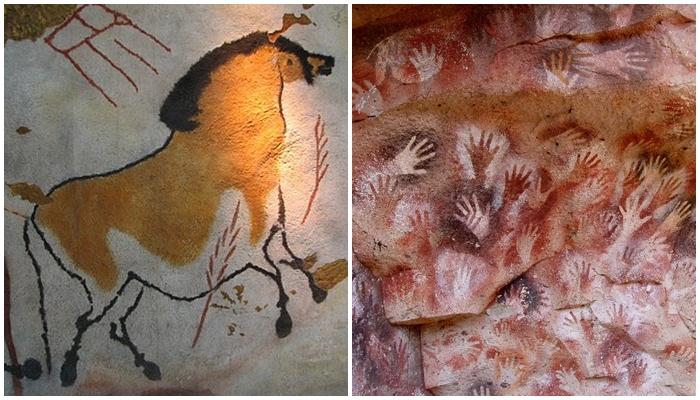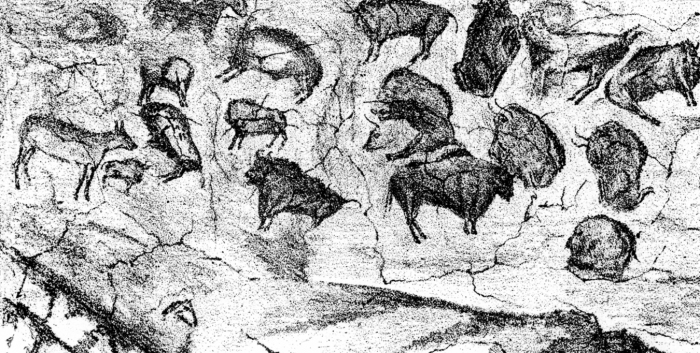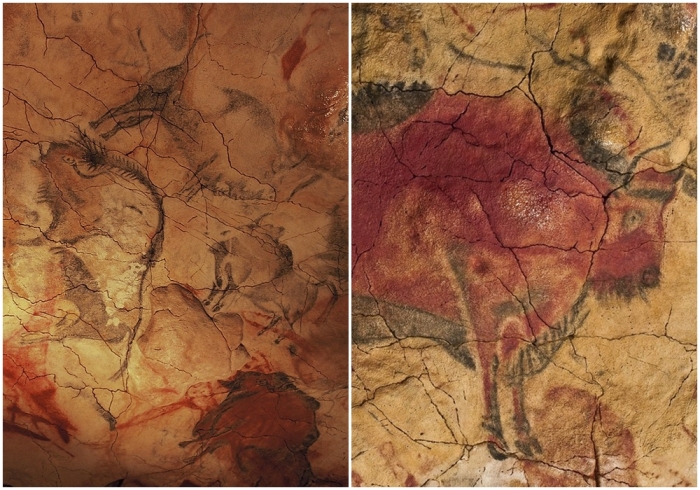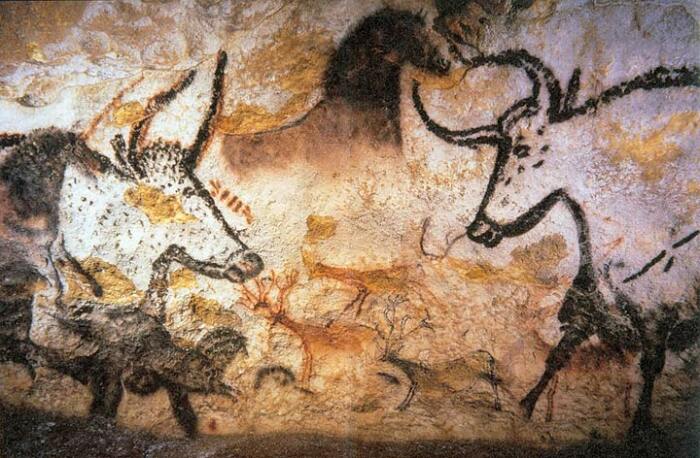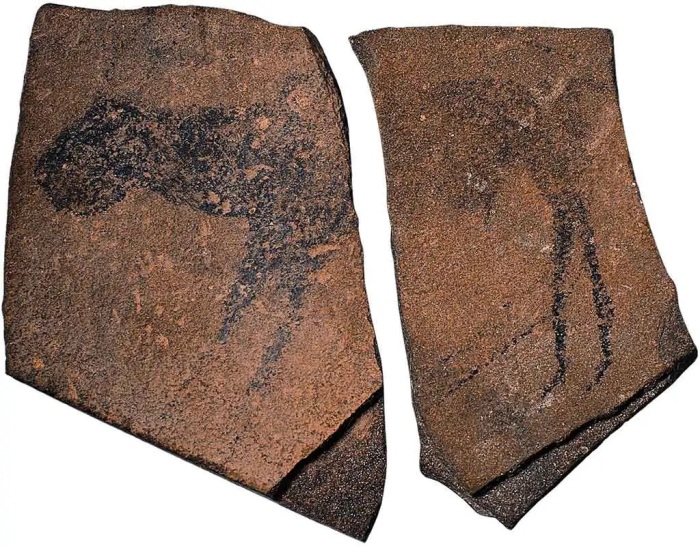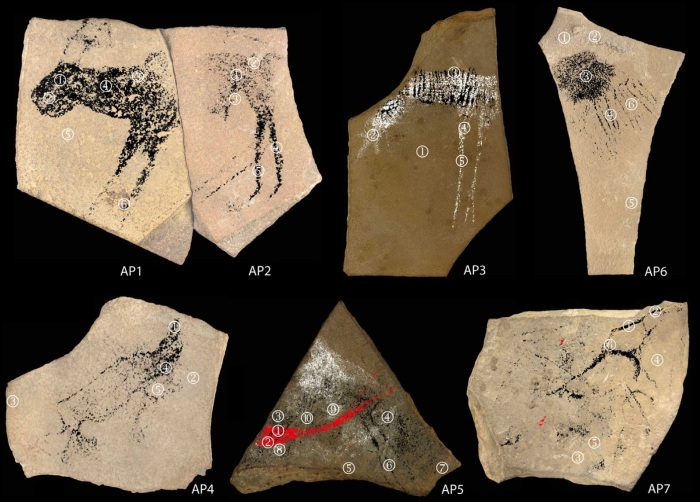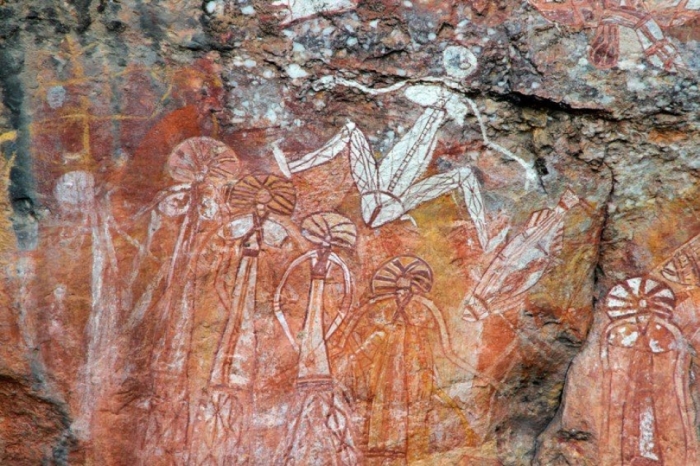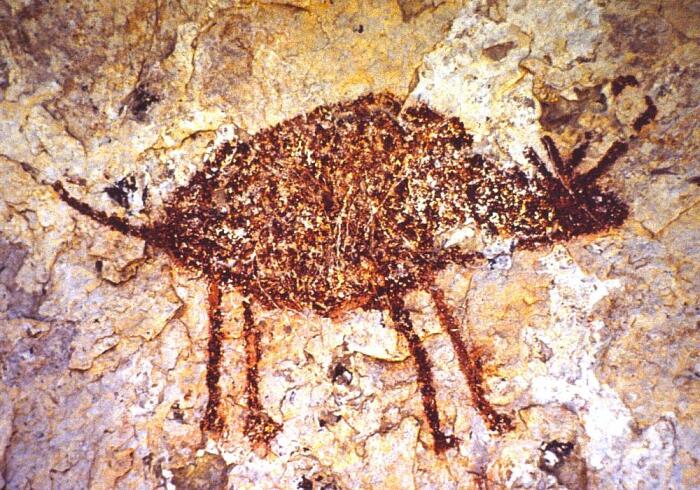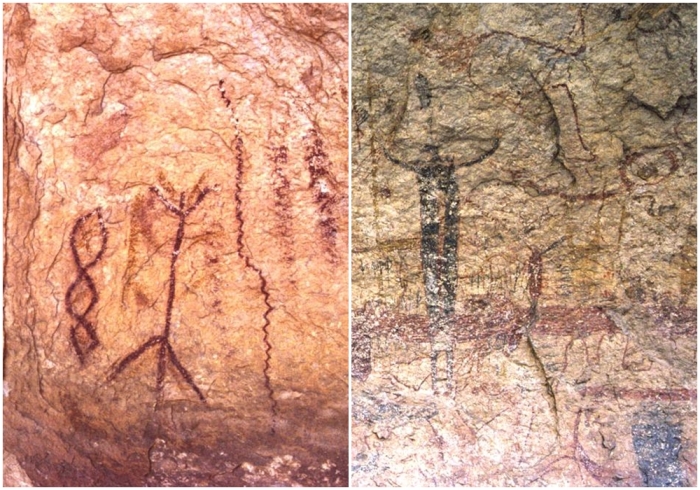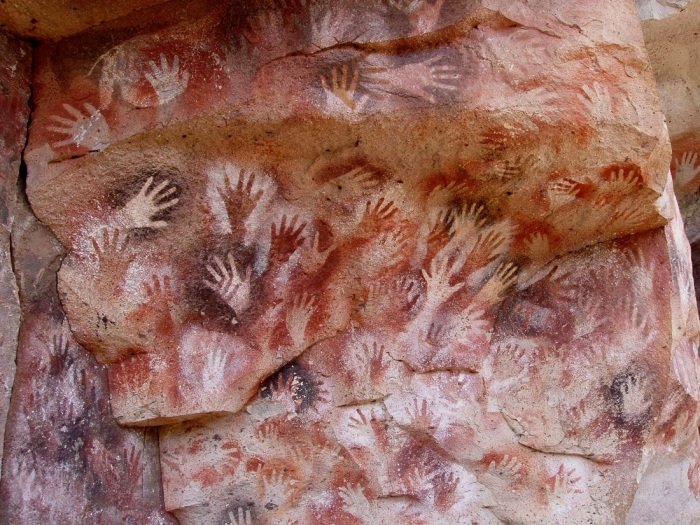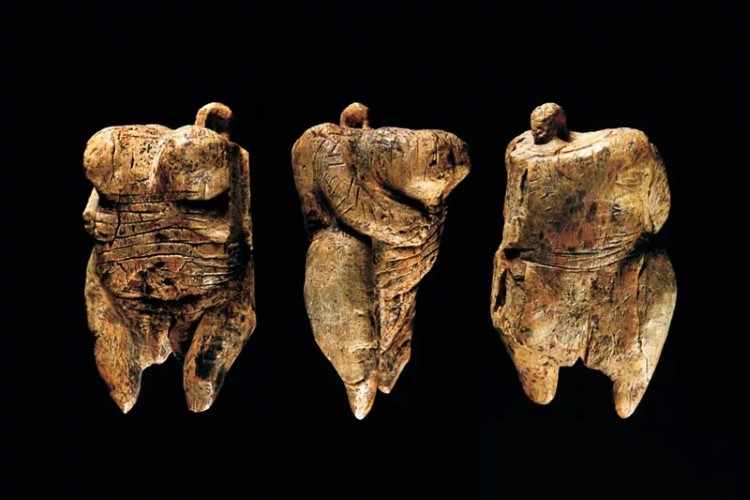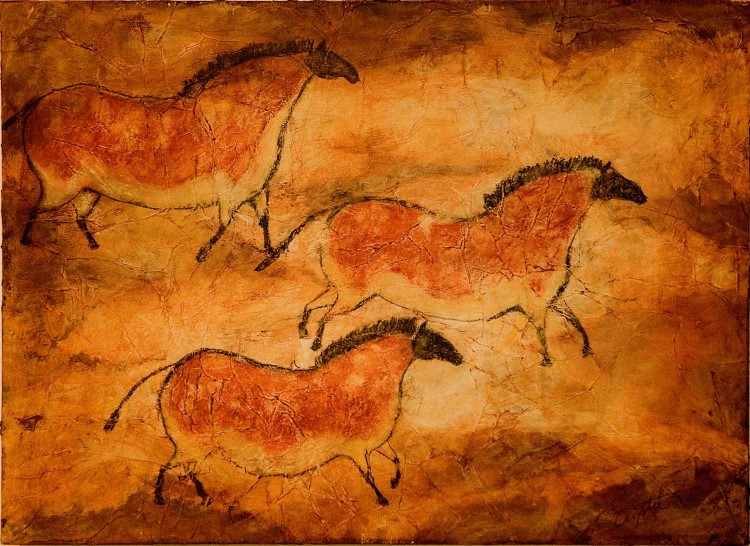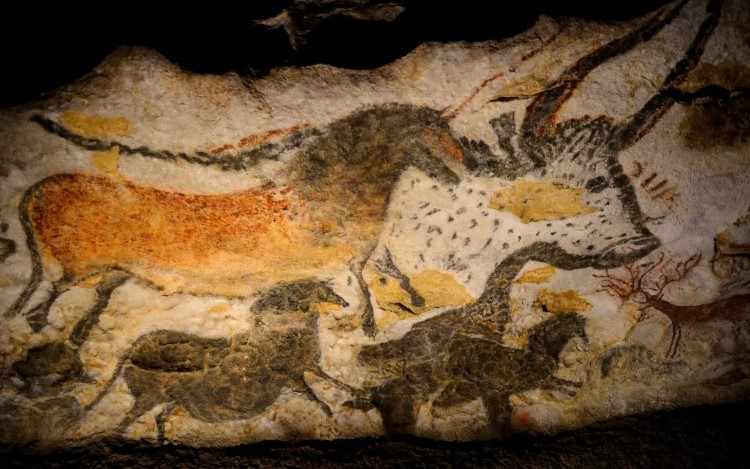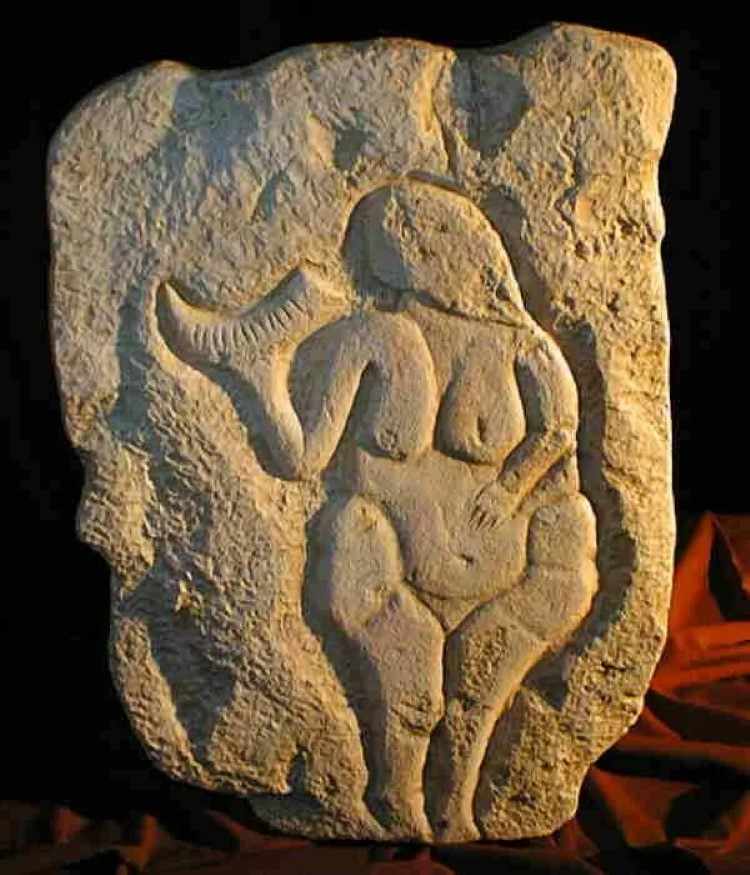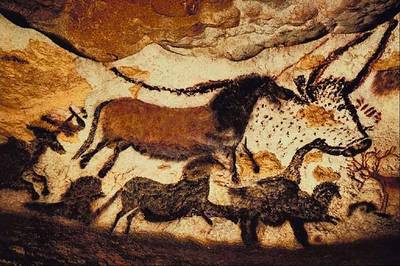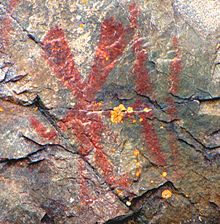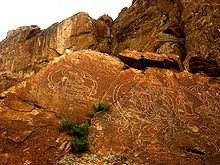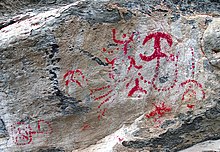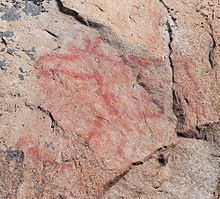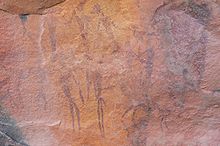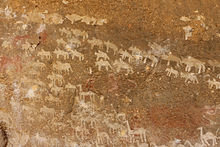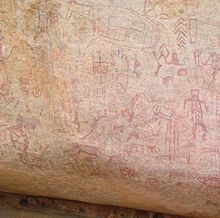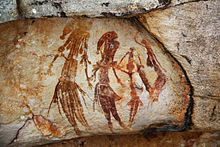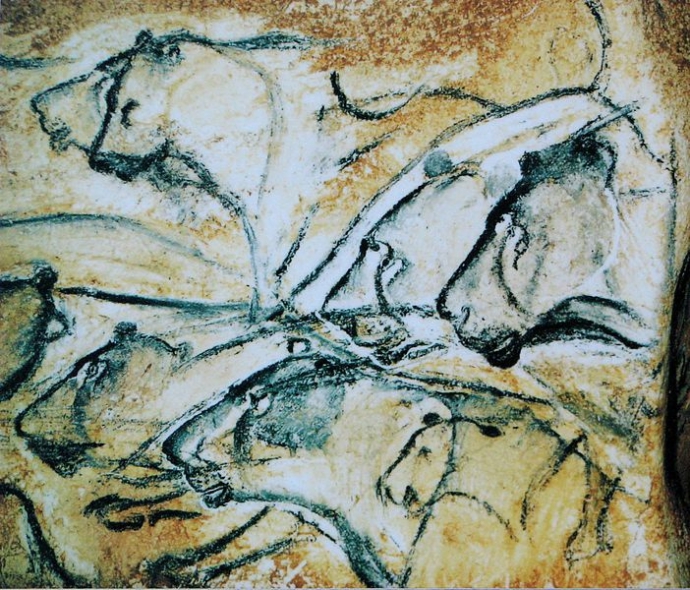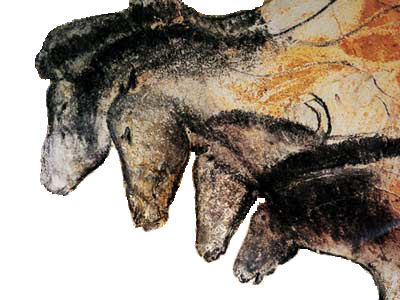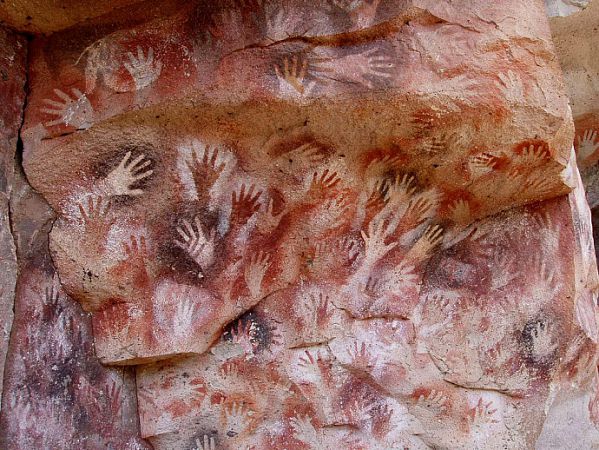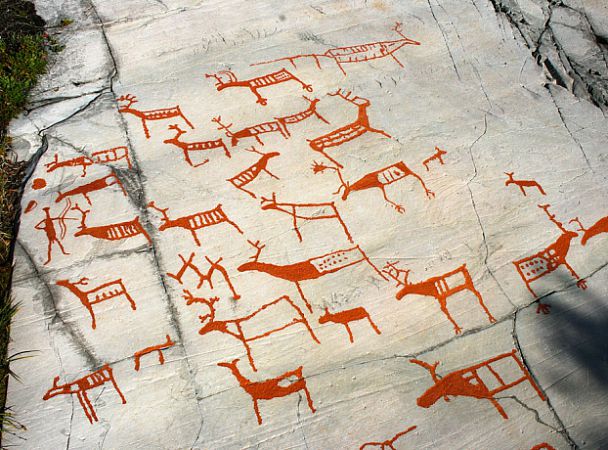Доисторические наскальные рисунки и резьба являются одними из самых захватывающих произведений искусства в мире. Они представляют собой стилизованных животных и людей, отпечатки рук и геометрические символы, выгравированные на камне или окрашенные натуральными пигментами, такими как охра и древесный уголь. И совсем неудивительно, что подобного рода творчество частенько поддаётся различного рода интерпретациям от охоты и шаманизма до духовно-религиозных ритуалов.
Наскальные рисунки Альтамиры, Испания
Наскальные рисунки с изображенеим бизонов, пещера Альтамира. Фото: en.wikipedia.org.
Наскальные рисунки в Альтамире, Испания, были первыми в мире, признанными доисторическими произведениями искусства, но потребовались годы, чтобы этот факт стал общепринятым. Первыми исследователями Альтамиры были археологи-любители, в том числе испанский дворянин Марселино Санс де Саутуола и его дочь Мария. На самом деле, именно благодаря наблюдательности двенадцатилетней Марии, была обнаружена серия больших из вполне себе реалистично нарисованных бизонов на потолке пещеры.
Пещера Альтамира и наскальное искусство периода палеолита на севере Испании.
Впоследствии было найдено много других реалистичных рисунков и гравюр с животными. У дона Саутуолы хватило дальновидности, чтобы правильно связать эти грандиозные и сложные наскальные рисунки с мелкомасштабными доисторическими объектами (единственное доисторическое искусство, известное в то время). Однако эксперты изначально не пришли к единому мнению. В то время археология была очень новой областью изучения и ещё не достигла того уровня, когда доисторические люди считались способными создавать какие-либо сложные произведения искусства. Только когда подобные места начали обнаруживаться позже в девятнадцатом веке, в первую очередь во Франции, эксперты, наконец, признали Альтамиру подлинным артефактом ледникового периода.
Ласко, Франция
Иногда Ласко называют «Сикстинская капелла первобытной живописи». Фото: google.com.
Обнаруженные в 1940 году несколькими детьми и их собакой, пещеры Ласко на протяжении многих десятилетий были родиной европейского наскального искусства. Французский священник и любитель доисторических времён аббат Анри Брей назвал её «Сикстинской капеллой доисторических времён».
Несмотря на то, что в 1994 году была обнаружена пещера Шове (также во Франции) с её потрясающими изображениями животных, датируемыми более чем 30 000-летней давностью, наскальные рисунки в Ласко по-прежнему являются одними из самых известных в мире благодаря реалистичным и динамичным изображениям таких животных, как лошади, бизоны, мамонты и олени, запечатлённых на волнистых стенах пещеры.
Слева направо: Лошадь из Ласко, точная копия в Брненском музее Антропос. Наскальный рисунок гигантского оленя в пещере Ласко.
Существует также загадочная фигура гибрида человека и животного, иногда называемая «птичьим человеком». Его коннотации остаются неуловимыми, но могут относиться к религиозным верованиям, ритуалам или шаманизму.
В отличие от Альтамиры, пещеры Ласко с самого начала привлекли положительное внимание общественности, несмотря на то, что были обнаружены в разгар Второй мировой войны. К сожалению, несколько десятилетий интенсивного потока посетителей поставили под угрозу изображения, которые идеально сохранялись на протяжении стольких тысячелетий, будучи защищёнными от воздействия человека и окружающей среды внутри пещер. Вот почему, как и многие другие популярные места наскального искусства, пещеры Ласко сейчас закрыты для посетителей в целях их собственной защиты.
ЧИТАТЬ ТАКЖЕ: Какие неожиданные находки сделал Марко Поло в своих путешествиях: Крокодилы, бумажные деньги, специи и др >>
Пещерные камни Аполлона-11, Намибия
Один из камней Аполлона-11. Фото: bing.com.
Наскальная живопись изобилует в Африке, по меньшей мере сто тысяч памятников были обнаружены с доисторических времён до девятнадцатого века. Но к сожалению практически все они были не до конца изучены. Несмотря на это, было сделано несколько замечательных находок. Одной из них являются пещерные камни «Аполлон-11». Эти картины находятся на множестве гранитных плит, отделённых от любой постоянной поверхности скалы. Всего есть семь маленьких плит, и вместе они представляют шесть животных, нарисованных углем, охрой и белым пигментом. Есть зебра и носорог рядом с неопознанным четвероногим в двух частях и ещё три камня со слабыми и неопределёнными изображениями. Их возраст составляет примерно двадцать пять тысяч лет.
Пещерные камни Аполлона-11, Намибия. Фото: pbs.twimg.com.
Другие ключевые африканские находки включают пещеру Бломбос и наскальные рисунки Дракенсбурга, оба в Южной Африке. В Бломбосе нет сохранившихся наскальных рисунков, но здесь есть свидетельства изготовления красок и пигментов, а также мастерская раннего художника, которой примерно сто тысяч лет. Между тем, сайт Дракенсбурга содержит бесчисленные изображения людей и животных, сделанные народами Сан на протяжении тысячелетий, пока они не были вынуждены покинуть свои исконные земли относительно недавно. Такие проекты, как Фонд африканского наскального искусства и проект изображения африканского наскального искусства в Британском музее, в настоящее время работают над записью и сохранением этих древних памятников.
Национальный парк Какаду и другие места наскального искусства, Австралия
Наскальные рисунки Какаду. Фото: parksaustralia.gov.au.
Люди жили в районе, который сейчас является национальным парком Какаду, около Арнем-Лэнд на северном побережье Австралии, примерно шестидесят тысяч лет назад. Сохранившиеся там рисунки были созданы более двадцати пяти тысяч лет назад, но последняя картина перед тем, как этот район стал национальным парком, была сделана в 1972 году художником-аборигеном по имени Найомболми.
В разные периоды существовали разные стили и сюжеты. Обладая такой невероятно долгой историей искусства, Какаду представляет несколько фантастических свидетельств тысячелетнего изменения климата в этом районе — на картинах появляются животные, ныне вымершие в этом районе. Подобное явление наблюдалось в таких местах, как Сахара, где растения и животные в наскальных рисунках являются реликвиями того времени, когда местность была пышной и зелёной, а вовсе не пустыней.
Некоторые наскальные рисунки Гвион-Гвион в районе Кимберли в Австралии. Фото: npr.brightspotcdn.com.
Наскальные рисунки особенно многочисленны в Австралии; по одной из оценок, существует около 150 000-250 000 возможных мест по всей стране, особенно в регионах Кимберли и Арнем-Лэнд. Сегодня это остаётся важным компонентом религии коренных народов, поскольку они связаны с основополагающей концепцией аборигенов, известной как «Сновидение». Эти древние картины по-прежнему обладают огромной духовной силой и значением для современных коренных народов.
ЧИТАТЬ ТАКЖЕ: Как за 5 минут научиться отличать минойское искусство от микенского >>
Наскальные рисунки Нижнего Пекоса в Техасе и Мексике
Крупный план фигуры животного, возможно, представляющего оленя. Фото: texasbeyondhistory.net.
Несмотря на то, что наскальные рисунки Нижнего каньона Пекос на границе Техаса и Мексики довольно молоды по доисторическим меркам (самым старым образцам четыре тысячи лет), в них присутствуют все элементы лучшего наскального искусства в мире. Особый интерес представляют многочисленные фигуры «антропоморфов» — термин, который исследователи дали сильно стилизованным человекоподобным формам, встречающимся повсюду в пещерах Пекос.
Слева направо: Крупный план красных линейных пиктограмм. Пиктограммы в стиле народов Пекоса в каньоне Гремучей змеи.
Они изображены с замысловатыми головными уборами, атлатлями и другими атрибутами. По мнению учёных и историков, эти антропоморфы скорее всего изображают шаманов и события из шаманских трансов. Также были найдены изображения животных и геометрических символов, и их образы были предварительно связаны с мифами и обычаями коренных культур близлежащих районов, включая ритуалы с использованием галлюциногенного вещества мескалина, полученного из кактуса пейота. Однако нет никаких окончательных доказательств того, что наскальные рисунки, приписываемые народу Пекоса, придерживались тех же верований, что и более поздние группы, поскольку связи между наскальным искусством и современными традициями коренных народов здесь не так сильны, как те, которые иногда встречаются в Австралии.
Куэва-де-лас-Манос или Пещера рук, Аргентина
Сцена охоты, Куэва-де-лас-Манос (Пещера рук), Аргентина. Фото: argentinamakenahubbard.weebly.com.
Отпечатки ладоней или тыльной стороны кистей, окружённые облаком цветной краски, нанесённой с помощью выдувных трубок, являются общей чертой наскального искусства, встречающегося во множестве мест и периодов времени. Они часто появляются рядом с другими изображениями животных или геометрических фигур по всему миру. Но существует одно место, которое больше всего славится ими: Куэва-де-лас-Манос (Пещера рук) в Патагонии, Аргентина, содержащая около 830 отпечатков ладоней и тыльных сторон кистей вместе с изображениями людей, лам, сцен охоты и многого другого в пещере в драматической обстановке каньона. Картины были датированы периодом 9000-летней давности. Изображения Куэва-де-лас-Манос с красочными отпечатками рук, покрывающими каждую поверхность, динамичны, завораживающи и довольно трогательны.
Сулавеси и Борнео, Индонезия
Доисторические отпечатки рук в пещере Петтакере, Индонезия. Фото: images.chr.bg.
В 2014 году было обнаружено, что наскальные рисунки в пещерах Марос-Пангкеп на индонезийском острове Сулавеси были созданы примерно сорок-сорок пять тысяч лет назад. Изображающие формы животных и отпечатки ладоней, эти картины стали претендентами на звание старейших наскальных рисунков в мире.
В 2018 году на Борнео были найдены рисунки людей и животных примерно одинакового возраста, а в 2021 году в пещере Леанг Тедонгнге, опять же в Сулавеси, была обнаружена картина с изображением местной индонезийской бородавчатой свиньи. В настоящее время некоторые считают её старейшей известной изобразительной картиной в мире. Эти находки двадцать первого века стали первыми, которые заставили учёных серьёзно задуматься о том, что первое искусство человечества необязательно родилось в пещерах Западной Европы.
В следующей статье читайте о том, какие факты были открыты современными учёными о Мезоамериканской цивилизации.
Понравилась статья? Тогда поддержи нас, жми:
Человек тяготел к искусству всегда. Доказательством этого являются многочисленные наскальные рисунки по всей планете, созданные нашими предками десятки тысяч лет назад. Первобытное творчество является свидетельством того, что люди жили повсюду – от жаркой африканской саванны до полярного круга. Америка, Китай, Россия, Европа, Австралия – везде древние художники оставили свои знаки. Не следует думать, что первобытная живопись совсем примитивна. Встречаются среди наскальных шедевров и весьма искусные работы, удивляющие красотой и техникой исполнения, раскрашенные яркими красками и несущие в себе глубокий смысл.
Петроглифы и наскальная живопись древних людей
Пещера Куэва-де-лас-Манос
Пещера находится на юге Аргентины. Долгое время здесь обитали предки индейцев Патагонии. На стенах пещеры найдены рисунки, отображающие сцену охоты на диких животных, а также множество негативных изображений рук мальчиков-подростков. Ученые сделали предположение, что нанесение контура руки на стену – часть обряда инициации. В 1999 году пещера была включена в список Всемирного наследия ЮНЕСКО
Национальный парк Серра-да-Капивара
После обнаружения множества памятников наскальной живописи, местность, расположенная в бразильском штате Пиауи, была объявлена национальным парком. Еще во времена доколумбовой Америки парк Серра-да-Капивара был густонаселенной территорией, здесь концентрировалось большое количество общин предков современных индейцев. Наскальные рисунки, созданные при помощи угля, красного гематита и белого гипса, датируются 12-9 тысячелетием до нашей эры. Они относятся к культуре Нордести.
Пещера Ласко
Памятник периода позднего палеолита, один из наиболее хорошо сохранившихся на территории Европы. Пещера находится во Франции в долине реки Везер. В середине XX века в ней были обнаружены рисунки, созданные 18-15 тысяч лет назад. Они относятся к древней солютрейской культуре. Изображения располагаются в нескольких пещерных залах. Наиболее внушительные 5 метровые рисунки животных, напоминающих зубров, находятся в «Зале быков».
Национальный парк Какаду
Местность располагается на севере Австралии примерно в 170 км от города Дарвин. На протяжении последних 40 тысяч лет на территории нынешнего национального парка проживали аборигены. Они оставили любопытные образцы первобытной живописи. Это изображения сцен охоты, шаманские обряды и сюжеты сотворения мира, выполненные в особенной «рентгеновской» технике.
Найн-Майл-Каньон
Ущелье в США на востоке штата Юта длиной почти 60 км. Его даже прозвали самой протяженной художественной галереей из-за серии наскальных петроглифов. Некоторые созданы с помощью природных красок, другие выбиты прямо в породе. Большинство изображений создали индейцы фремонтской культуры. Помимо рисунков, интерес представляют пещерные жилища, дома-колодцы и старинные хранилища зерна.
Капова пещера
Археологический памятник, расположенный в Башкортостане на территории заповедника Шульган-Таш. Длина пещеры более 3 км, вход в виде арки 20 метров в высоту и 40 метров в ширину. В 1950-х годах в четырех залах грота были обнаружены первобытные рисунки эпохи палеолита – около 200 изображений животных, антропоморфных фигур и абстрактных символов. Большинство из них созданы с использованием красной охры.
Долина Чудес
Национальный парк Меркантур, который называют «Долиной Чудес», находится неподалеку от Лазурного Берега. Помимо природных красот, туристов привлекает гора Бего – настоящий археологический памятник, где были обнаружены десятки тысяч древних картин бронзового века. Это геометрические фигуры непонятного назначения, религиозные символы и прочие загадочные знаки.
Пещера Альтамира
Пещера находится на севере Испании в автономном сообществе Кантабрия. Она прославилась своими наскальными рисунками, которые выполнены в полихромной технике с использованием множества естественных красителей: охры, гематита, угля. Изображения относятся к мадленской культуре, существовавшей 15-8 тысяч лет до нашей эры. Древние художники были настолько искусны, что сумели придать изображениям бизонов, лошадей и кабанов трехмерный облик, используя естественные неровности стены.
Пещера Шове
Исторический памятник Франции, расположенный в долине реки Ардеш. Около 40 тысяч лет назад пещеру населяли древние люди, оставившие после себя более 400 рисунков. Самым старым изображениям более 35 тысяч лет. Росписи прекрасно сохранились благодаря тому, что долгое время до Шове не могли добраться, ее обнаружили только в 1990-х годах. К сожалению, доступ туристов в пещеру запрещен.
Тадрарт-Акакус
Когда-то на территории жаркой и практически бесплодной Сахары была плодородная и зеленая местность. Тому есть много свидетельств, в том числе – наскальные рисунки, обнаруженные в Ливии на территории горного массива Тадрарт-Акакус. По этим изображениям можно изучать эволюцию климата в этой части Африки, и проследить превращение цветущей долины в пустыню.
Вади-Метхандуш
Еще один шедевр наскального искусства на территории Ливии, расположенный на юго-западе страны. Рисунки Вади-Метхандуш изображают сцены с животными: слонами, кошачьими, жирафами, крокодилами, быками, антилопами. Считается, что самые древние были созданы 12 тысяч лет назад. Наиболее известная картина и неофициальный символ местности – две крупные кошки, сошедшиеся в поединке.
Лаас-Гааль
Пещерный комплекс в непризнанном государстве Сомалиленд с прекрасно сохранившимися древними рисунками. Эти росписи считаются наиболее уцелевшими среди всех на Африканском континенте, они датируются 9-3 тысячелетиями до нашей эры. В основном, они посвящены священной корове – культовому животному, которому поклонялись в этих местах. Изображения были обнаружены в начале 2000-х годов французской экспедицией.
Скальные жилища Бхимбетка
Находятся в Индии, в штате Мадхья Прадеш. Считается, что в пещерном комплексе Бхимбетка жили еще эректусы (Homo erectus — человек прямоходящий) непосредственные предки современных людей. Рисунки, обнаруженные индийскими археологами, относятся к эпохе мезолита. Интересно, что многие обряды жителей окрестных деревень похожи на сцены, изображенные древними людьми. Всего в Бхимбетке около 700 пещер, из которых хорошо изучены более 300.
Беломорские петроглифы
Рисунки первобытных людей находятся на территории археологического комплекса «Беломорские петроглифы», куда входит несколько десятков стоянок древних людей. Изображения расположены в месте под названием Залавруга на берегу Белого моря. Всего коллекция состоит из 2000 объединенных в группы иллюстраций, изображающих людей, животных, сражения, ритуалы, сцены охоты, также есть любопытная картина человека на лыжах.
Петроглифы Тассилин-Адджер
Горное плато в Алжире, на территории которого расположены самые масштабные рисунки древних людей, обнаруженные на севере Африки. Петроглифы стали появляться здесь с 7 тысячелетия до нашей эры. Основной сюжет – сцены охоты и фигуры животных африканской саванны. Иллюстрации выполнены в разных техниках, что свидетельствует об их принадлежности к разным историческим эпохам.
Цодило
Горный массив Цодило находится в пустыне Калахари в Ботсване. Здесь на площади более 10 км² были обнаружены тысячи изображений, созданных древними людьми. Исследователи утверждают, что они охватывают временной период 100 тысяч лет. Самые древние творения – примитивные контурные изображения, более поздние представляют собой попытку художников придать рисункам трехмерный эффект.
Томская писаница
Природный музей-заповедник в Кемеровской области, созданный в конце 1980-х годов с целью сохранения наскальной живописи. На его территории располагаются около 300 изображений, многие из них созданы примерно 4 тысячи лет назад. Самые ранние датируются X веком до нашей эры. Помимо творчества древнего человека, туристам будет интересно посмотреть на этнографическую выставку и музейные коллекции, входящие в состав Томской писаницы.
Пещера Магура
Природный объект находится на северо-западе Болгарии неподалеку от города Белоградчик. Во время археологических раскопок в 1920-х годах здесь были найдены первые свидетельства пребывания древнего человека: орудия труда, керамика, украшения. Также были обнаружены более 700 образцов наскальных рисунков, созданных предположительно 100-40 тысяч лет назад. Помимо фигур животных и людей, на них изображены звезды и солнце.
Заповедник Гобустан
Заповедная территория включает в себя грязевые вулканы и древнюю наскальную живопись. Более 6 тысяч изображений создавали люди, жившие на этой земле с первобытной эпохи и до Средних веков. Сюжеты довольно просты – сцены охоты, религиозных обрядов, фигуры людей и животных. Гобустан находится в Азербайджане примерно в 50 км от Баку.
Онежские петроглифы
Петроглифы были обнаружены на восточном берегу Онежского озера в Пудожском районе Карелии. Рисунки, датируемые 4-3 тысячелетиями до наше эры, размещены на скалах нескольких мысов. Некоторые иллюстрации имеют довольно внушительные 4 метровые размеры. Помимо стандартных изображений людей и животных, есть и мистические символы непонятного назначения, которые всегда пугали монахов расположенной неподалеку Муромской Свято-Успенской обители.
Наскальные рельефы в Тануме
Группа петроглифов, открытая в 1970-х годах на территории шведской коммуны Танум. Они располагаются вдоль 25-километровой линии, которая в бронзовом веке, предположительно, была берегом фьорда. Всего археологи обнаружили примерно 3 тысячи рисунков, собранных в группы. К сожалению, под влиянием неблагоприятных природных условий петроглифы находятся под угрозой исчезновения. Постепенно становится все сложнее различить их очертания.
Наскальные рисунки в Альте
Первобытные люди обитали не только в комфортном теплом климате, но и около Полярного круга. В 1970-х годах на севере Норвегии у города Альта ученые обнаружили большую группу доисторических рисунков, состоящую из 5 тысяч фрагментов. На этих картинах изображена жизнь человека в суровых погодных условиях. Некоторые иллюстрации содержат орнаменты и знаки, которые ученым не удалось расшифровать.
Археологический парк долины Коа
Археологический комплекс, созданный на месте обнаружения доисторической живописи, которая относится к периодам палеолита и неолита (так называемая солютрейская культура). Здесь есть не только древние изображения, некоторые элементы были созданы в Средние века. Рисунки расположены на скалах, протянувшихся на 17 км вдоль реки Коа. Также в парке есть Музей искусства и археологии, посвященный истории местности.
Ньюспейпер-Рок
В переводе название археологического памятника означает «Газетный камень». Действительно, петроглифы, покрывающие скалу, напоминают характерную типографскую печать. Гора располагается в американском штате Юта. Доподлинно не установлено, когда были созданы эти знаки. Считается, что на утес их наносили индейцы как до прихода на континент европейских завоевателей, так и после этого.
Пещеры Эдаккал
К одному из археологических достояний Индии и всего человечества можно отнести пещеры Эдаккал в штате Керала. В эпоху неолита на стены гротов были нанесены доисторические петроглифы. Эти символы еще не удалось расшифровать. Местность является популярным туристическим объектом, посещение пещер возможно только в составе экскурсии. Самостоятельный вход запрещен.
Петроглифы археологического ландшафта Тамгалы
Урочище Тамгалы находится примерно в 170 км от Алма-Аты. В 1950-х годах на его территории было обнаружено около 2 тысяч наскальных рисунков. Большая часть изображений была создана в бронзовом веке, также есть современные творения, появившиеся в эпоху Средних веков. Основываясь на характере рисунков, ученые выдвинули предположение, что в Тамгалы располагалось древнее святилище.
Петроглифы монгольского Алтая
Комплекс наскальных знаков, расположенный на территории Северной Монголии, занимает площадь 25 км² и тянется в длину на 40 км. Изображения были созданы в эпоху неолита более 3 тысяч лет назад, есть рисунки и подревнее, возрастом в 5 тысяч лет. На большинстве из них фигурируют олени с колесницами, также есть фигуры охотников и сказочных животных, напоминающих драконов.
Наскальная живопись в горах Хуа
Китайские наскальные художества были обнаружены на юге страны в горном массиве Хуа. Они представляют собой фигуры людей, животных, кораблей, небесных тел, оружия, окрашенные в цвет насыщенной охрой. Всего здесь насчитывается около 2 тысяч изображений, которые условно разделены на 100 групп. Некоторые картинки складываются в полноценные сюжеты, где можно разглядеть торжественную церемонию, ритуал или шествие.
Пещера Пловцов
Грот располагается в Ливийской пустыне на границе Египта и Ливии. В 1990-х годах там были обнаружены древние петроглифы, возраст которых превышает 10 тысяч лет (эпоха неолита). Они изображают плавающих в море или в ином водоеме людей. Именно поэтому пещеру назвали ее современным именем. После того, как грот стали массово посещать люди, многие рисунки начали портиться.
Хорсшу-Каньон
Ущелье входит в состав национального парка Кaньонлeндс, который находится в американском штате Юта. Хорсшу-Каньон стал знаменитым благодаря тому, что в 1970-х годах здесь обнаружили древние рисунки, созданные кочевыми охотниками-собирателями. Изображения нанесены на панели около 5 метров в высоту и 60 метров в ширину, они представляют собой 2-метровые человекоподобные фигуры.
Петроглифы Валь-Камоники
В первой половине XX века в итальянской долине Валь-Камоника (область Ломбардия) было обнаружено самое большое собрание наскальных изображений в мире – более 300 тысяч рисунков. Основная их часть была создана в железном веке, самые поздние относятся к культуре камунов, о которой пишут еще древнеримские источники. Любопытно, что, когда у власти в Италии находился Б. Муссолини, эти петроглифы считали доказательством зарождения высшей арийской расы.
Долина Твифелфонтейн
Самые древние поселения появились в намибийской долине Твифелфонтейн более 5 тысяч лет назад. Примерно в это же время были созданы наскальные рисунки, изображающую типичную жизнь охотников и кочевников. Всего ученые насчитали более 2,5 тысяч фрагментов, большинству из них около 3 тысяч лет, самым молодым – около 500 лет. В середине XX века кто-то украл внушительную часть плит с петроглифами.
Чумашская расписная пещера
Национальный парк в штате Калифорния, на территории которого располагается небольшой грот из песчаника с настенной росписью индейцев-чумашей. Сюжеты картин отражают представления аборигенов о мироустройстве. По разным оценкам, рисунки были созданы в период от 1 тысячи до 200 лет назад, что делает их вполне современными по сравнению с доисторической наскальной живописью в других местах мира.
Петроглифы Торо-Муэрто
Группа петроглифов в перуанской провинции Кастилья, которые были созданы в VI-XII веках во времена культуры Уари. Некоторые ученые предполагают, что к ним приложили руку инки. На рисунках изображены животные, птицы, небесные тела, геометрические орнаменты, а также люди в танце, вероятно, исполняющие какой-то ритуал. Всего удалось обнаружить около 3 тысяч разрисованных камней вулканического происхождения.
Петроглифы острова Пасхи
Одно из самых загадочных мест планеты, остров Пасхи, может удивить не только гигантскими каменными головами. Древние петроглифы, нанесенные на скалы, валуны, стены пещер вызывают не меньший интерес и считаются важным археологическим наследием. Они представляют собой то ли схематические изображения технического процесса, то ли несуществующих животных и растения – ученым только предстоит разобраться в этом вопросе.
Что такое наскальная живопись? Определение, характеристики
В доисторическом искусстве термин «наскальная живопись» охватывает любое теменное искусство, которое включает нанесение цветных пигментов на стены, полы или потолки древних скальных убежищ. Монохромная пещерная живопись — это живопись, выполненная только одним цветом (обычно черным). Многоцветная наскальная живопись состоит из двух или более цветов, примером чему служат великолепные разноцветные изображения бизонов на потолке в Альтамире или великолепные зубры в Камере Быков в Ласко. Напротив, термин «наскальный рисунок» относится (строго говоря) только к выгравированному рисунку, то есть рисунку, сделанному путем вырезания линий на поверхности скалы кремневым или каменным инструментом, а не путем рисования линий углем или марганцем.
Происхождение и история
В настоящее время у нас нет четкого представления о том, когда впервые появилась наскальная живопись. Одна из теорий связывает эволюцию искусства каменного века с появлением анатомически современных людей в Европе в период верхнего палеолита. Согласно этой теории, развитие пещерного искусства совпало с вытеснением неандертальца анатомически современным человеком, начиная примерно с 40 000 года до нашей эры. Действительно, примерно с этой даты в пещерах и скальных укрытиях по всему миру, но особенно во Франко-Кантабрийском регионе, начали появляться самые ранние наскальные рисунки. На первом месте стоит живопись, за ней следует передвижное искусство, примером которого являются переносные статуэтки Венеры, такие как Венера из Хохле-Фельса (38-33 000 лет до н. э.).
Вообще говоря, техника и материалы для наскальной живописи совершенствовались по всем направлениям, столетие за столетием. Таким образом, мы видим, как монохромные картины ориньякской культуры (40-25 000 лет до н.э.) уступают место полихромному искусству граветта (25-20 000 лет до н.э.), что приводит к апогею наскальной живописи, которая, как традиционно считается, происходит в эпоху Магдалины (около 15-10 000 лет до н. э.) в Ласко, Альтамире, Фон де Гом и Ле Комбарель. В конце Магдалины закончился ледниковый период, и период глобального потепления привел к уничтожению среды обитания магдалинийских северных оленей, а также их культуры и пещерного искусства. Подробнее об эволюции наскальной живописи и о том, как она вписывается в культуру каменного века.
Типы
Большинство доисторических наскальных рисунков были фигуративными, и 99 процентов из них были изображениями животных. Сначала художники каменного века рисовали хищных животных (львов, носорогов, саблезубых кошек, медведей) почти так же часто, как и охотничьих животных, таких как бизон и северный олень, но начиная с солютрейской эпохи в изображениях преобладали охотничьи животные. Изображения людей были исключительно редким явлением и обычно были сильно стилизованы и гораздо менее натуралистичны, чем изображения животных. Абстрактные изображения (знаки, символы и другие геометрические знаки) также были распространены и фактически представляют собой древнейший тип палеолитического искусства, найденный в пещерах позднего каменного века, как показывают недавние результаты датировки картин в Эль-Кастильо и Альтамире.
В дополнение к рисункам и абстрактным изображениям, доисторические пещеры также сильно украшены раскрашенными вручную трафаретами наскальных рисунков, большинство из которых, согласно недавним исследованиям декана Сноу из Университета штата Пенсильвания, были сделаны женщинами, но также участвовали мужчины и дети. Одними из лучших примеров этой формы живописи являются Ручные трафареты пещеры Гаргас (Верхняя Гаронна), Панель ручных трафаретов в Шове (Ардеш) и гравюры по всей Куэва-де-лас-Манос (Пещера Рук) в Аргентине.
Наскальная живопись в три этапа
Как правило, полихромная пещерная живопись создавалась в три основных этапа, которые могли существенно различаться в зависимости от опыта и культурной зрелости художника, характера и контуров поверхности скалы, силы и типа света, а также доступного сырья. Сфотографируйте, например, бизона. Во-первых, контур и основные черты животного рисуются на стене пещеры либо путем заострения поверхности скалы заостренным камнем, либо путем нанесения черного контура с помощью древесного угля или марганца. Во-вторых, завершенный рисунок животного будет окрашен или заполнен красной охрой или другими пигментами. В-третьих, края тела животного будут затенены черным или другим пигментом, чтобы увеличить его трехмерность. В качестве альтернативы, в зависимости от того, делал ли это необходимым контур стены пещеры, для увеличения объема и рельефа применялась дополнительная гравировка или даже скульптура.
Где находится большинство наскальных рисунков?
Наиболее впечатляющие образцы этого наскального искусства были обнаружены на юго-западе Франции и севере Испании — поэтому его иногда называют франко-кантабрийским наскальным искусством — где археологи обнаружили около 350 пещер, содержащих произведения искусства верхнего палеолита. Самые большие скопления пещер находятся в Дордони (Ласко, Куссак, Лоссель, Фон-де-Гом, Ле-Комбарель, Руффиньяк) и вокруг Монте-Кастильо в районе Пуэнте-Вьесго, Кантабрия, но другие великолепно украшенные пещеры были найдены в разных частях мира, включая Южную Африку, Аргентину, Индию, Китай, Австралию и другие.
Какие самые древние наскальные рисунки?
В настоящее время самое раннее искусство в доисторических пещерах, даты происхождения которого были подтверждены радиоуглеродным датированием, состоит из абстрактных знаков, а именно красной точки и отпечатка руки, найденных среди наскальных рисунков Эль-Кастильо в Кантабрии, Испания. Эти изображения датируются по меньшей мере 39 000 годом до н.э. и 35 500 годом до н.э. соответственно, что делает их древнейшим произведением искусства такого типа из пещеры в Европе.
Однако в 2014 году в Индонезии, на другом конце света, археологи использовали методы уран-ториевого датирования, чтобы датировать ручные трафареты среди изображений, найденных в пещере Леанг Тимпусенг, Сулавеси, 37 900 годом до нашей эры. (Рисунки животных на этом месте были датированы 33 400 годом до н.э.) Далее по возрасту идут изображения пещеры Фумане (около 35 000 лет до н. э.), затем два символа в форме ключа, найденные в Альтамире, датированные 34 000 годом до н. э. Следующие по древности картины находятся в пещере Шове, расположенной в регионе Ардеш во Франции. Они были обнаружены в 1994 году и датируются 30 000 годом до нашей эры. Наиболее продуктивными периодами пещерного искусства были граветтская и магдаленская культуры, датируемые 25 000-200 000 годами до н.э. и 15 000-10000 годами до н. э. соответственно.
Примечание: Многие пещеры содержат свидетельства повторяющейся живописи, иногда растянувшейся на десятки тысяч лет. Поэтому некоторые из этих «пещерных студий» могут оказаться старше, чем первоначально предполагалось. Это именно то, что произошло в Альтамире, где основная часть произведений искусства относится к периоду Магдалины (около 15 000 лет до н. э.), но недавние тесты показали, что одно конкретное абстрактное изображение относится к ориньякской эпохе около 34 000 лет до н. э.
Какие картины рисовались в доисторических пещерах?
Художники каменного века создавали разнообразные фигуративные и абстрактные изображения. На натуралистических картинах в основном изображены сцены охоты или изображения животных — обычно бизонов, лошадей, северных оленей, крупного рогатого скота, зубров и мамонтов, хотя было изображено множество других существ, таких как: львы, овцебыки, ослы, сайгаки, серны, волки, лисы, зайцы, выдры, гиены, тюлени, рыбы, рептилии, птицы и другие существа. Но в доисторическом искусстве нет пейзажной живописи или даже каких-либо изображенных элементов пейзажа, таких как горы или реки. Изображения людей появляются очень редко: даже тогда они похожи на людей, а не на реальных людей. Хорошими примерами являются: «раненые» в Куньяке; картина человека с птичьей головой в «Шахте мертвеца» в Ласко; и гравированная картина «Колдун» в пещере Труа-Фрер.
Как уже упоминалось, абстрактное искусство также распространено. Стены пещеры изобилуют множеством точек, линий, знаков и символов. Например, исследователи из Университета Виктории на острове Ванкувер выявили более 20 знаков, нарисованных в одном стиле, которые снова и снова появляются в разных убежищах. Некоторые из них сделаны простыми мазками кисти, такими как круги, полукруги, треугольники и прямые линии; другие немного сложнее. В дополнение к только что упомянутым, они включают в себя: авиформы, клавиформы, сердечные формы, перекрестия, крестообразные, непонятые формы, отрицательные стрелки, открытые углы, овалы, пектиформы, пенниформы, положительные стрелки, четырехугольники, пениформы, скаляриформы, змеевидные формы, спирали, тектиформы, зигзаги и другие.
Какие методы живописи использовали художники каменного века?
Используя морские раковины в качестве контейнеров для краски и работая при лучинах или иногда при слабом солнечном свете, доисторические художники использовали самые разнообразные методы живописи. Сначала они рисовали пальцами, а затем переключились на комковатые пигментные мелки, подушечки из мха или кисти из шерсти животных или растительного волокна. Они также использовали более сложные методы окраски распылением с использованием тростника или специально выдолбленных костей. В пещере Альтамира была найдена выдолбленная кость птицы, окрашенная красной охрой, датируемая примерно 16 000 годом до н.э., что свидетельствует о том, что к этой дате солютреано-магдаленские художники, должно быть, были искусны в рисовании распылением. Художники каменного века также использовали технику ракурса и светотени. Каждая эпоха вводила новые методы наскальной живописи, и пещеры, украшенные на протяжении многих поколений, демонстрируют множество стилей — например, в пещере Ласко археологи выявили более дюжины различных стилей живописи.
Как доисторические художники делали краски?
Все цветные пигменты, используемые в наскальной живописи, были получены из местных источников, в основном из минеральных источников, найденных в земле. Художники каменного века использовали несколько различных комбинаций материалов для изготовления цветных красок. Глиняная охра давала три основных цвета: многочисленные разновидности красного, плюс желтый и коричневый. Для черного цвета художники использовали либо диоксид марганца, либо древесный уголь. После измельчения пигментов в мелкий порошок художники смешивали порошок с пещерной водой (обычно с высоким содержанием карбоната кальция), животными жирами, овощным соком, кровью или мочой, чтобы помочь ему прилипнуть к поверхности камня.
Они также использовали расширители, такие как биотит и полевой шпат, или молотый кварц и фосфат кальция (полученные из измельченных, нагретых костей животных). Вполне возможно, что художники были знакомы с пигментами благодаря живописи тела и лица — искусствам, которыми они занимались в течение тысячелетий, прежде чем начали украшать пещеры. Для получения более подробной информации о типе цветовых пигментов, используемых в наскальной живописи каменного века, см.: Доисторическая цветовая палитра.
Делали ли художники каменного века предварительные наброски?
Иногда. В пещере Ла-Ваш археологи обнаружили слой древесного угля под черным пигментом картин, указывающий на то, что предварительный набросок был сделан до нанесения краски. Чаще всего силуэт животного вместе с его основными чертами был выгравирован на скале кремнем, а затем окрашен пигментом.
Какова была цель этих наскальных рисунков?
Мы точно не знаем. Первоначально большинство палеоантропологов считали, что этот вид древнего искусства был чисто декоративным. Однако подробные археологические свидетельства показывают, что расписные пещеры не были населены обычными людьми. Вместо этого в них жила только небольшая группа художников или других людей, участвовавших в церемониальной деятельности и роли пещеры. В результате в настоящее время считается, что наскальная живопись была создана шаманами по церемониальным причинам — возможно, в связи с социальными, сверхъестественными или религиозными ритуалами. В используемой иконографии нет четкой закономерности, поэтому в настоящее время большинство теорий относительно точного значения или функции наскальной живописи каменного века являются всего лишь догадками.
Есть ли в доисторических пещерах скульптуры?
Да. Сохранилось несколько прекрасных образцов рельефной скульптуры. Они включают Венеру Лоссельскую (около 23 000 лет до н.э.), одну из шести скульптур-барельефов, выгравированных на большом блоке известняка в скальном укрытии Лоссель, недалеко от Ласко; а также знаменитые рельефные изображения зубра Тук д’Одубер (около 13 500 лет до н.э.), выполненные из необожженной глины, которые были найдены в Арьеже, Франция. Эксперты полагают, что доисторическая скульптура, возможно, была столь же распространена, как и настенная живопись, за исключением того, что большая ее часть разрушилась или погибла.
Похожие сообщения:
Наскальная живопись, что хотели рассказать древние люди
Мнение исследователей о пещерной живописи
Наскальная живопись очень интересная и загадочная часть древней истории. Многие археологи неоднократно пытались выяснить, что же первобытные люди хотели сказать своими рисунками и выдвинули несколько гипотез:
- Известно, что древние люди занимались охотой и собирательством, эти два занятия давали возможность жить племенам. Исследователи предположили, что накануне охоты племена изображали свою добычу или момент поимки животного. Таким образом мужчины программировали себя на успешное дело;
- Вторая гипотеза утверждает, что рисунки это возможность общения с охотниками и добытчиками. В каждом селении был уважаемый шаман, который имел возможность пообщаться с кормильцами. Для этого шаман входил в транс и зарисовывал на стенах скал свои видения;
- Еще одна гипотеза появилась совсем недавно, и она свидетельствует о том, что почти все рисунки в пещерах выполнены детьми подростками и лишь небольшая их часть выполнена женской рукой.
Но ученые не расстраиваются из-за таких разнообразных гипотез. Ведь благодаря наскальной живописи им удалось проследить изменение климата, растительности и животного мира на многих континентах нашей планеты. Именно наскальная живопись является доказательством того, что нынешняя пустыня Сахара во времена палеолита имела богатую экосистему. Также рисунки в пещерах помогли определить самые крупные селения, быт каждого племени, их опыт в выращивании растений и приручении животных.
Семья и отношения в рисунках первобытных людей
Как и современные люди, в первобытных общинах образовывались семьи, влюбленные пары заводили детей, можно даже сказать были очень похожи на современных людей. Рисунки в пещере были не только об охоте или собирательстве. Нередко в картинках на скалах можно рассмотреть фигуры оголенных мужчин и женщин в процессе интимной близости. Но еще более интересный факт древней семьи, это использование в своих эротических играх нынче популярных интим товаров, таких как на сайте http://intimshop.kz. Искусственный пенис при раскопках пещер находят не реже, чем предметы первой необходимости, расчески или иголки. Такие находки лишний раз доказывают, что древние люди очень похожи на нас. Наскальная живопись также является ярким доказательством того, что даже в первобытных общинах имело место развитие культуры.
Автор: Павел Чайка, главный редактор исторического сайта Путешествия во времени
При написании статьи старался сделать ее максимально интересной, полезной и качественной. Буду благодарен за любую обратную связь и конструктивную критику в виде комментариев к статье. Также Ваше пожелание/вопрос/предложение можете написать на мою почту pavelchaika1983@gmail.com или в Фейсбук, с уважением автор.
Not to be confused with cave paintings, a type of rock art placed on the walls and ceilings of caves; or art rock, a sub-genre of rock music.
Reclining Buddha at Gal Vihara, Sri Lanka, where the remains of two columns to support the structure that originally enclosed it is visible
In archaeology, rock art is human-made markings placed on natural surfaces, typically vertical stone surfaces. A high proportion of surviving historic and prehistoric rock art is found in caves or partly enclosed rock shelters; this type also may be called cave art or parietal art. A global phenomenon, rock art is found in many culturally diverse regions of the world. It has been produced in many contexts throughout human history. In terms of technique, the four main groups are:
- cave paintings,
- petroglyphs, which are carved or scratched into the rock surface,
- sculpted rock reliefs, and
- geoglyphs, which are formed on the ground.
The oldest known rock art dates from the Upper Palaeolithic period, having been found in Europe, Australia, Asia, and Africa. Anthropologists studying these artworks believe that they likely had magico-religious significance.
The archaeological sub-discipline of rock art studies first developed in the late-19th century among Francophone scholars studying the rock art of the Upper Palaeolithic found in the cave systems of parts of Western Europe. Rock art continues to be of importance to indigenous peoples in various parts of the world, who view them as both sacred items and significant components of their cultural heritage.[1] Such archaeological sites may become significant sources of cultural tourism and have been used in popular culture for their aesthetic qualities.[2]
Etymology[edit]
The term rock art appears in the published literature as early as the 1940s.[3][4] It has also been described as «rock carvings»,[5] «rock drawings»,[6] «rock engravings»,[7] «rock inscriptions»,[8] «rock paintings»,[9] «rock pictures»,[10] «rock records»,[11] and «rock sculptures.»[12][13]
Background[edit]
Parietal art is a term for art in caves; this definition usually extended to art in rock shelters under cliff overhangs. Popularly, it is called «cave art», and is a subset of the wider term, rock art. It is mostly on rock walls, but may be on ceilings and floors. A wide variety of techniques have been used in its creation. The term usually is applied only to prehistoric art, but it may be used for art of any date.[14] Sheltered parietal art has had a far better chance of surviving for very long periods, and what now survives may represent only a very small proportion of what was created.[15]
Both parietal and cave art refer to cave paintings, drawings, etchings, carvings, and pecked artwork on the interior of caves and rock shelters. Generally, these either are engraved (essentially meaning scratched) or painted, or, they are created using a combination of the two techniques.[16] Parietal art is found very widely throughout the world, and in many places new examples are being discovered.
The defining characteristic of rock art is that it is placed on natural rock surfaces; in this way, it is distinct from artworks placed on constructed walls or free-standing sculpture.[17] As such, rock art is a form of landscape art, and includes designs that have been placed on boulder and cliff faces, cave walls, and ceilings, and on the ground surface.[17] Rock art is a global phenomenon, being found in many different regions of the world.[1] There are various forms of rock art. Some archaeologists also consider pits and grooves in the rock known as cupules, or cups or rings, as a form of rock art.[17]
Although there are exceptions, the majority of rock art whose creation was recorded by ethnographers had been produced during rituals.[17] As such, the study of rock art is a component of the archaeology of religion.[18]
Rock art serves multiple purposes in the contemporary world. In several regions, it remains spiritually important to indigenous peoples, who view it as a significant component of their cultural heritage.[1] It also serves as an important source of cultural tourism, and hence as economic revenue in certain parts of the world. As such, images taken from cave art have appeared on memorabilia and other artefacts sold as a part of the tourist industry.[2]
Types[edit]
Paintings[edit]
In most climates, only paintings in sheltered sites, in particular caves, have survived for any length of time. Therefore, these are usually called «cave paintings», although many do survive in «rock-shelters» or cliff-faces under an overhang. In prehistoric times, these were often popular places for various human purposes, providing some shelter from the weather, as well as light. There may have been many more paintings in more exposed sites, that are now lost. Pictographs are paintings or drawings that have been placed onto the rock face. Such artworks have typically been made with mineral earths and other natural compounds found across much of the world. The predominantly used colours are red, black and white. Red paint is usually attained through the use of ground ochre, while black paint is typically composed of charcoal, or sometimes from minerals such as manganese. White paint is usually created from natural chalk, kaolinite clay or diatomaceous earth.[19] Once the pigments had been obtained, they would be ground and mixed with a liquid, such as water, blood, urine, or egg yolk, and then applied to the stone as paint using a brush, fingers, or a stamp. Alternately, the pigment could have been applied on dry, such as with a stick of charcoal.[20] In some societies, the paint itself has symbolic and religious meaning; for instance, among hunter-gatherer groups in California, paint was only allowed to be traded by the group shamans, while in other parts of North America, the word for «paint» was the same as the word for «supernatural spirit».[21]
One common form of pictograph, found in many, although not all rock-art producing cultures, is the hand print. There are three forms of this; the first involves covering the hand in wet paint and then applying it to the rock. The second involves a design being painted onto the hand, which is then in turn added to the surface. The third involves the hand first being placed against the panel, with dry paint then being blown onto it through a tube, in a process that is akin to air-brush or spray-painting. The resulting image is a negative print of the hand, and is sometimes described as a «stencil» in Australian archaeology.[22] Miniature stencilled art has been found at two locations in Australia and one in Indonesia.
Petroglyphs[edit]
Bidzar Petroglyphs in Cameroon
Petroglyphs are engravings or carvings into rock which is left in situ. They can be created with a range of scratching, engraving or carving techniques, often with the use of a hard hammerstone, which is battered against the stone surface. In certain societies, the choice of hammerstone itself has religious significance.[23] In other instances, the rock art is pecked out through indirect percussion, as a second rock is used like a chisel between the hammerstone and the panel.[23] A third, rarer form of engraving rock art was through incision, or scratching, into the surface of the stone with a lithic flake or metal blade. The motifs produced using this technique are fine-lined and often difficult to see.[24]
Rock reliefs[edit]
Normally found in literate cultures, a rock relief or rock-cut relief is a relief sculpture carved on solid or «living rock» such as a cliff, rather than a detached piece of stone. They are a category of rock art, and sometimes found in conjunction with rock-cut architecture.[25] However, they tend to be omitted in most works on rock art, which concentrate on engravings and paintings by prehistoric peoples. A few such works exploit the natural contours of the rock and use them to define an image, but they do not amount to man-made reliefs. Rock reliefs have been made in many cultures, and were especially important in the art of the Ancient Near East.[26] Rock reliefs are generally fairly large, as they need to be to make an impact in the open air. Most have figures that are over life-size, and in many the figures are multiples of life-size.
Stylistically they normally relate to other types of sculpture from the culture and period concerned, and except for Hittite and Persian examples they are generally discussed as part of that wider subject.[27] The vertical relief is most common, but reliefs on essentially horizontal surfaces are also found. The term typically excludes relief carvings inside caves, whether natural or themselves man-made, which are especially found in India. Natural rock formations made into statues or other sculpture in the round, most famously at the Great Sphinx of Giza, are also usually excluded. Reliefs on large boulders left in their natural location, like the Hittite İmamkullu relief, are likely to be included, but smaller boulders may be called stelae or carved orthostats.
Earth figures[edit]
Earth figures are large designs and motifs that are created on the stone ground surface. They can be classified through their method of manufacture.[28] Intaglios are created by scraping away the desert pavements (pebbles covering the ground) to reveal a negative image on the bedrock below. The best known example of such intaglio rock art is the Nazca Lines of Peru.[28] In contrast, geoglyphs are positive images, which are created by piling up rocks on the ground surface to resulting in a visible motif or design.[28]
Motifs and panels[edit]
Traditionally, individual markings are called motifs and groups of motifs are known as panels. Sequences of panels are treated as archaeological sites. This method of classifying rock art however has become less popular as the structure imposed is unlikely to have had any relevance to the art’s creators. Even the word ‘art’ carries with it many modern prejudices about the purpose of the features.[citation needed]
Rock art can be found across a wide geographical and temporal spread of cultures perhaps to mark territory, to record historical events or stories or to help enact rituals. Some art seems to depict real events whilst many other examples are apparently entirely abstract.[citation needed]
Prehistoric rock depictions were not purely descriptive. Each motif and design had a «deep significance» that is not always understandable to modern scholars.[29]
Interpretation and use[edit]
Religious interpretations[edit]
In many instances, the creation of rock art was itself a ritual act.[24]
Regional variations[edit]
Europe[edit]
In the Upper Palaeolithic of Europe, rock art was produced inside cave systems by the hunter-gatherer peoples who inhabited the continent. The oldest known example is the Chauvet Cave in France, although others have been located, including Lascaux in France, Alta Mira in Spain and Creswell Crags in Britain and Grotta del Genovese in Sicily.
Balma dei Cervi post-palaeolithic rock paintings (Italian western Alps): antropomorphic figures and dottings (DStretch enhanced)
The late prehistoric rock art of Europe has been divided into three regions by archaeologists. In Atlantic Europe, the coastal seaboard on the west of the continent, which stretches from Iberia up through France and encompasses the British Isles, a variety of different rock arts were produced from the Neolithic through to the Late Bronze Age. A second area of the continent to contain a significant rock art tradition was that of Alpine Europe, with the majority of artworks being clustered in the southern slopes of the mountainous region, in what is now south-eastern France and northern Italy.
- Finnish Rock Art
- Knowth
- Loughcrew
- Newgrange
- Neolithic and Bronze Age rock art in the British Isles
- Rock Drawings in Valcamonica (World Heritage Site)
- Balma dei Cervi at Crodo (Piedmont — Italian Alps)
- Grotta dei Cervi at Porto Badisco (Apulia — Italy)
- Grotta del Genovese (Sicily)
- List of rock carvings in Norway
- Rock carvings at Alta (World Heritage Site)
- Madara Rider (World Heritage Site)
- Côa Valley Paleolithic Art (World Heritage Site)
- Cave of Altamira and Paleolithic Cave Art of Northern Spain (World Heritage Site)
- Rock art of the Iberian Mediterranean Basin (World Heritage Site)
- Tanum (World Heritage Site)
- Tanums hällristningsmuseum [sv],[30] Rock Art Research Centre and World Heritage Archive, situated in Tanum, Sweden.
Africa[edit]
Long-horned cattle and other rock art in the Laas Geel complex
North Africa[edit]
- South Oran in Algeria.
- Saharan rock art
- Tadrart Acacus in Libya – World Heritage Site.
- Tassili n’Ajjer in Algeria – national park and World Heritage Site, known for its 10,000-year-old paintings.
- Cave of Swimmers is a cave in southwest Egypt, near the border with Libya, along the western edge of the Gilf Kebir plateau in the central Libyan Desert (Eastern Sahara). It was discovered in October 1933 by the Hungarian explorer László Almásy. The site contains rock paintings of human figures who appear to be swimming, which have been estimated to have been created at least 6,000 to 7000 years ago. The Cave of Beasts 10 km westwards was discovered in 2002.
- Jebel Uweinat, a large granite and sandstone mountain, as well as the adjacent smaller massifs of Jebel Arkenu and Jebel Kissu at the converging triple borders of Libya, Egypt and Sudan, harbors one of the richest concentrations of prehistoric rock art in the entire Sahara. The rock art here mainly consists of the Neolithic cattle pastoralist cultures, but also a number of older paintings from hunter-gatherer societies.
- Sabu-Jaddi rock art site in Northern Sudan.
- North Sİnai Archaeological Sites Zone − World Heritage Site.[31] Limestone cave decorated with scenes of animals such as donkeys, camels, deer, mule and mountain goats was uncovered in the site in 2020. Rock art cave is 15 meters deep and 20 meters high.[32]
- Wadi Abu Dom
Western Africa[edit]
- Boucle du Baoulé National Park
- Dabous Giraffes
East Africa[edit]
Rock art in the Adi Alauti cave, Eritrea
- Qohaito in Eritrea – 7,000 years old rock art near the ancient city Qohaito.
- Dorra and Balho in Djibouti – Rock art sites with figures of what appear to be antelopes and a giraffe.
- Kundudo in Ethiopia – Flat top mountain complex with rock art in a cave.
- Laas Geel in Somalia – A number of cave paintings and petroglyphs can be found at various sites across the country. Among the most prominent examples of this is the rock art in Laas Geel, Dhambalin, Gaanlibah and Karinhegane.
- Nyero Rockpaintings, Uganda-World Heritage Site, pre-historic paintings was noticed before 1250 AD[33]
- Swaga Swaga Game Reserve in Tanzania – Archaeologists announced the discovery of ancient rock art with anthropomorphic figures in a good condition at the Amak’hee 4 rockshelter site. Paintings made with a reddish dye also contained buffalo heads, giraffe’s head and neck, domesticated cattle dated back to about several hundred years ago.[34][35]
- Bahi rock paintings
- Chabbé
- Dhaymoole
- Handoga
- Kondoa Rock-Art Sites
- Mfangano Island
- Rock art of Uganda
Southern Africa[edit]
Cave paintings are found in most parts of Southern Africa that have rock overhangs with smooth surfaces. Among these sites are the cave sandstone of Natal, Orange Free State and North-Eastern Cape, the granite and Waterberg sandstone of the Northern Transvaal, and the Table Mountain sandstone of the Southern and Western Cape.[36]
- UKhahlamba Drakensberg Park in South Africa – The site has paintings dated to around 3,000 years old and which are thought to have been drawn by the San people and Khoisan people, who settled in the area some 8,000 years ago. The rock art depicts animals and humans and is thought to represent religious beliefs.
- Tsodilo Hills in Botswana – A World Heritage Site with rock art
- Brandberg Mountain (Daureb) in Namibia – It is one of the most important rock art localities on the African continent. Most visitors only see «The White Lady» shelter (which is neither white, nor a lady, the famous scene probably depicts a young boy in an initiation ceremony), however the upper reaches of the mountain is full of sites with prehistoric paintings, some of which rank among the finest artistic achievements of prehistory.
- Bambata Cave, Zimbabwe- Animal paintings and human drawings are supposed to be age from 2.000 to 20.000 years old[37][38][39]
- Mwela and Adjacent Areas Rock Art Site, Zambia
- Chongoni Rock Art Area
- Driekops Eiland
- Modderpoort Sacred Sites
- Nooitgedacht Glacial Pavements
- Nyambwezi Falls
- San rock art
- Twyfelfontein
- Wildebeest Kuil Rock Art Centre
The Americas[edit]
The oldest reliably dated rock art in the Americas is known as the «Horny Little Man.» It is petroglyph depicting a stick figure with an oversized phallus and carved in Lapa do Santo, a cave in central-eastern Brazil.[40] The most important site is Serra da Capivara National Park at Piauí state. It is a UNESCO World Heritage Site with the largest collection in the American continent and one of the most studied.
A site including eight miles of paintings or pictographs that is under study in Colombia, South America at Serranía de la Lindosa was revealed in November 2020.[41] Their age is suggested as being 12,500 years old (c. 10,480 B.C.) by the anthropologists working on the site because of extinct fauna depicted.
Rock paintings or pictographs are located in many areas across Canada. There are over 400 sites attributed to the Ojibway from northern Saskatchewan to the Ottawa River.[42]
- Pomier Caves, Dominican Republic
- Naj Tunich, Guatemala
- Rock Paintings of Sierra de San Francisco, Baja California, Mexico
- Sierra de Guadalupe cave paintings, Baja California, Mexico
- Pictograph Cave Complex, Billings, Montana, United States
- Cañon Pintado, Colorado, United States
- Chaco Culture National Historical Park, New Mexico, United States
- Chumash rock art, California, United States
- Coso Rock Art District, California, United States
- Nine Mile Canyon, Utah, United States
- Quail rock art panel, Utah, United States
- Painted Rocks, Arizona, United States
- Petroglyph National Monument, New Mexico, United States
- Serra da Capivara National Park, Piauí, Brazil
- Vale do Catimbau National Park, Pernambuco, Brazil.
- Localidad Rupestre de Chamangá, Uruguay
- Writing-on-Stone Provincial Park, Alberta, Canada
- Cueva de las Manos, Santa Cruz Province, Argentina
- Huerfano Butte, Arizona, United States
- Petroglyphs Provincial Park, Ontario, Canada
- Serranía La Lindosa, Guaviare Department, Colombia[43][41]
Asia[edit]
Petroglyphs in Gobustan, Azerbaijan, dating back to 10,000 BC.
Rock art in Balichakra near Yadgir town in Karnataka, India
Central Asia[edit]
- Gobustan National Park in Azerbaijan
- Petroglyphs of Arpa-Uzen, Kazakhstan
- Siypantosh Rock Paintings in Uzbekistan
- Zarautsoy Rock Paintings in Uzbekistan
East Asia[edit]
- Bangudae Petroglyphs, in South Korea
- Cheonjeon-ri in South Korea[44]
- Daegok-ri in South Korea[44]
- Fugoppe Cave petroglyphs on Hokkaido, Japan[44]
- Helankou in Yinchuan, China[44]
- Kangjia shimenzi in Xinjiang, China[44]
- Oponoho (Wanshan) petroglpyhs in Taiwan[44]
- Temiya Cave on Hokkaido, Japan[44]
- Yinshan petroglyphs in the Yin Mountains, China
- Zuo River Huashan rock art in Guangxi, China[44]
- Chifeng Petroglyphs in Inner Mongolia
- Above 4000 meters above sea level high Tibetan plateau: possibly the oldest rock art, likely dating back to ∼169–226,000 years ago, much older than what was previously thought to be the earliest known drawing, made ~73,000[45] years ago. According to the study, children likely intentionally placed a series of hands and feet in mud. The findings could also be the earliest evidence of Hominins on the high Tibetan plateau.[46][47][48]
Southeast Asia[edit]
- Angono Petroglyphs, the Philippines
- Bir Hima Rock Petroglyphs and Inscriptions
- Pettakere cave, South Sulawesi, Indonesia – hand print paintings
- Pha Taem in Thailand
- Tambun rock art, Malaysia
South Asia[edit]
- Bhimbetka rock shelters (World Heritage Site), Madhya Pradesh, India with rock art ranging from the Mesolithic (c.8,000 BC) to historical times[49][50][51][52][53][54]
- Edakkal Caves, Kerala India
- Gavali, Udupi
- Hire Benakal, Karnataka
- Balichakra, Yadgir town in Karnataka, India
- Rock paintings of Tamil Nadu, in India (several sites)[55]
- Kaimur district, Bihar, India (several sites)
- Rock paintings of Andhra Pradesh, in India (several sites)[55]
- Sonda, Karnataka
Western Asia[edit]
- Rock Art in the Ha’il Region in Saudi Arabia
- Iranian rock art sites are mostly found in the Zagros Mountain range. But there are many other sites in Central Iran, Sistan and Baluchistan, and Azarbaijan. Most of these rock arts date back to the late prehistory and historic period. Among which the well-known sites of Houmian at Kuhdasht,[56] Khomein, and Teimareh[57] in Central Iran are outstanding.
- Large carvings of camels that were discovered in 2018 in Saudi Arabia are estimated to be 7,000 to 8,000 years old.[58] This Neolithic dating would make the carvings significantly older than Stonehenge (5,000 years old) and the Egyptian pyramids at Giza (4,500 years old).
Australasia[edit]
Australia[edit]
Australian Indigenous art represents the oldest unbroken tradition of art in the world. There are more than 100,000 recorded rock art sites in Australia.[59]
The oldest firmly dated rock-art painting in Australia is a charcoal drawing on a rock fragment found during the excavation of the Nawarla Gabarnmang rock shelter in south western Arnhem Land in the Northern Territory. Dated at 28,000 years, it is one of the oldest known pieces of rock art on Earth with a confirmed date. Nawarla Gabarnmang is considered[by whom?] to have one of the most extensive collections of rock art in the world and predates both Lascaux and Chauvet cave art — the earliest known art in Europe — by at least 10,000 years.[60][61]
In 2008 rock art depicting what is thought to be a Thylacoleo was discovered[by whom?] on the north-western coast of the Kimberley.[62] As the Thylacoleo is believed to have become extinct 45000–46000 years ago (Roberts et al. 2001) (Gillespie 2004), this suggests a similar age for the associated Gwion Gwion rock paintings. Archaeologist Kim Akerman however believes that the megafauna may have persisted later in refugia (wetter areas of the continent) as suggested by Wells (1985: 228) and has suggested a much younger age for the paintings.[62] Pigments from the Gwion Gwion of the Kimberley are so old they have become part of the rock itself, making carbon dating impossible. Some experts suggest that these paintings are in the vicinity of 50,000 years old and may even pre-date Aboriginal settlement.[63][64]
Miniature rock art of the stencilled variety at a rock shelter known as Yilbilinji, in the Limmen National Park in the Northern Territory, is one of only three known examples of such art. Usually stencilled art is life-size, using body parts as the stencil, but the 17 images of designs of human figures, boomerangs, animals such as crabs and long-necked turtles, wavy lines and geometric shapes are very rare. Found in 2017 by archaeologists, the only other recorded examples are at Nielson’s Creek in New South Wales and at Kisar Island in Indonesia. It is thought that the designs may have been created by stencils fashioned out of beeswax.[65][66][67]
- Kakadu National Park in the Northern Territory has a large collection of ochre paintings. Ochre is a not an organic material, so carbon dating of these pictures is impossible. Sometimes the approximate date, or at least an epoch, can be guessed from the content.
- The Sydney region has important rock engravings.
- Mount Grenfell Historic Site near Cobar, western New South Wales has important ancient rock-drawings.
- The Murujuga (Burrup Peninsula) area of Western Australia near Karratha is estimated[by whom?] to be home to between 500,000 and 1 million individual engravings.
- Kimberley region of Western Australia. Amateur archaeologist Grahame Walsh, who researched Gwion Gwion rock paintings in the region from 1977 until his death in 2007, produced a photographic database of 1.5 million Gwion Gwion rock paintings.[68] Many of the Gwion rock paintings maintain vivid colours because they have been colonised by bacteria and fungi, such as the black fungus, Chaetothyriales. The pigments originally applied may have initiated an ongoing, symbiotic relationship between black fungi and red bacteria.[69]
- The Grampians-Gariwerd region is Victoria is one of the richest Aboriginal rock art sites in south-eastern Australia.[70] Some of the more well-known and easily accessible sites are the Ngamadjidj Shelter (Cave of Ghosts), Gulgurn Manja (Flat Rock), Billimina (Glenisla Shelter) and Manja (Cave of Hands);[71] one of the most significant sites in south-eastern Australia is Bunjil’s Shelter, near Stawell,[72] which is the only known rock art depiction of Bunjil, the creator-being in Aboriginal Australian mythology.[73]
- The Maliwawa Figures in Arnhem Land, a series of 571 paintings and a drawing, created between 6,000 and 9,400 years ago, show a style nor recognised by researchers in the field before new research was done in 2016–2018 and published in September 2020 by Paul Taçon and his team.[74][75]
- The Turramurra site in western Queensland is opening in 2020. Cliffs on the property, for some time known as Grace Vale Station, are covered with ancient rock art, including paintings and etchings of megafauna, emu symbols and the traditional songline of the Seven Sisters. Planning for an educational centre created from local rock is under way.[76]
New Zealand[edit]
In New Zealand, North Otago and South Canterbury have a rich range of early Māori rock art.[77]
- The Takiroa Rock Art Shelter near Duntroon contains Māori artwork made from ochre and charcoal.[78]
Studies[edit]
The archaeological sub-discipline devoted to the investigation of rock art is known as «rock art studies.» Rock art specialist David S. Whitley noted that research in this area required an «integrated effort» that brings together archaeological theory, method, fieldwork, analytical techniques and interpretation.[79]
History[edit]
Although French archaeologists had undertaken much research into rock art, Anglophone archaeology had largely neglected the subject for decades.[80]
The discipline of rock art studies witnessed what Whitley called a «revolution» during the 1980s and 1990s, as increasing numbers of archaeologists in the Anglophone world and Latin America turned their attention to the subject.[81] In doing so, they recognised that rock art could be used to understand symbolic and religious systems, gender relations, cultural boundaries, cultural change and the origins of art and belief.[1] One of the most significant figures in this movement was the South African archaeologist David Lewis-Williams, who published his studies of San rock art from southern Africa, in which he combined ethnographic data to reveal the original purpose of the artworks. Lewis-Williams would come to be praised for elevating rock art studies to a «theoretically sophisticated research domain» by Whitley.[82] However, the study of rock art worldwide is marked by considerable differences of opinion with respect to the appropriateness of various methods and the most relevant and defensible theoretical framework.
International databases and archives[edit]
The UNESCO World Rock Art Archive Working Group met in 2011 to discuss the base model for a World Rock Art Archive.[83] While no official output has been generated to date various projects around the world, such as for example The Global Rock Art Database,[84][85] are looking at making rock art heritage information more accessible and more visible to assist with rock art awareness, conservation and preservation issues.
See also[edit]
- List of Stone Age art
- Mulka’s Cave
- The Kindness Rocks Project
Notes[edit]
- ^ a b c d Whitley 2005, p. 1.
- ^ a b Whitley 2005, pp. 1–2.
- ^ E. Goodall, Proceedings and Transactions of the Rhodesian Scientific Association 41:57-62, 1946: «Domestic Animals in rock art»
- ^ E. Goodall, Proceedings and Transactions of the Rhodesian Scientific Association 42:69-74, 1949: «Notes on certain human representations in Rhodesian rock art»
- ^ H. M. Chadwick, Origin Eng. Nation xii. 306, 1907: «The rock-carvings at Tegneby»
- ^ H. A. Winkler, Rock-Drawings of Southern Upper Egypt I. 26, 1938: «The discovery of rock-drawings showing boats of a type foreign to Egypt.»
- ^ H. G. Wells, Outl. Hist. I. xvii. 126/1, 1920: From rock engravings we may deduce the theory that the desert was crossed from oasis to oasis.
- ^ Deutsch, Rem. 177, 1874: «The long rock-inscription of Hamamât.»
- ^ Encycl. Relig. & Ethics I. 822/2, 1908: «The rock-paintings are either stenciled or painted in outline.»
- ^ Man No. 119. 178/2, 1939: «On one of the stalactite pillars was found a big round stone with traces of red paint on its surface, as used in the rock-pictures»
- ^ G. Moore, The Lost Tribes and the Saxons of the East, 1861, Title page: «with translations of Rock-Records in India.»
- ^ Tylor, Early Hist. Man. v. 88, 1865, «and bush art or bushmen art.»
- ^ Trust For African Rock Art, East Africa, common terminology, «Rock-sculptures may often be symbolic boundary marks.»
- ^ Bahn, 99-101
- ^ Bahn, 101
- ^ Bahn, 101-105
- ^ a b c d Whitley 2005, p. 3.
- ^ Whitley 2005. pp. 3–4.
- ^ Whitley 2005, p. 4.
- ^ Whitley 2005, pp. 4–5.
- ^ Whitley 2005, p. 9.
- ^ Whitley 2005, pp. 7–9.
- ^ a b Whitley 2005, p. 11.
- ^ a b Whitley 2005, p. 13.
- ^ Harmanşah (2014), 5–6
- ^ Harmanşah (2014), 5–6; Canepa, 53
- ^ for example by Rawson and Sickman & Soper
- ^ a b c Whitley 2005, p. 14.
- ^ Arca 2004, p. 319.
- ^ «Scandinavian Society for Prehistoric Art». www.rockartscandinavia.se. Archived from the original on 2013-10-25. Retrieved 2022-03-01.
- ^ Centre, UNESCO World Heritage. «North Sinai archaeological Sites Zone». UNESCO World Heritage Centre. Retrieved 2020-09-09.
- ^ «Ancient cave with distinguished engravings depicting scenes of animals discovered in Sinai — Ancient Egypt — Heritage». Ahram Online. Retrieved 2020-09-09.
- ^ «NYERO & OTHER ROCK ARTSITES IN EASTERN UGANDA» (PDF).
- ^ «Tanzanian Rock Art Depicts Trios of Bizarre Anthropomorphic Figures | Archaeology | Sci-News.com». Breaking Science News | Sci-News.com. Retrieved 2021-02-16.
- ^ «Mysterious and bizarre: scientists discovered ancient rock art that dates back to several hundred years ago». www.msn.com. Retrieved 2021-02-16.
- ^ Standard Encyclopaedia of Southern Africa (1973)
- ^ «Stone Age — Africa». Encyclopedia Britannica. Retrieved 2018-10-20.
- ^ «Big Cave Camp | Famous Rock Art Galleries — visits to Nswatugi cave, Bambata, Silozwane cave, Inanke cave and Maholoholo cave». Big Cave. Retrieved 2018-10-20.
- ^ «Rock Paintings Bambata Cave (1)». Global-Geography. Retrieved 2018-10-20.
- ^ Choi, Charles. «Call this ancient rock carving ‘little horny man’.» Science on NBC News. 22 Feb 2012. Retrieved 9 April 2012.
- ^ a b Alberge, Dalya, ‘Sistine Chapel of the ancients’ rock art discovered in remote Amazon forest, The Guardian, Sunday, November 29, 2020
- ^ Grace Rajnovich. (1994) Reading rock art: interpreting the Indian rock paintings of the Canadian Shield. Toronto:Natural Heritage/Natural History Inc.
- ^ «Research news — Newly discovered Amazon rock art show the rainforest’s earliest inhabitants living with giant Ice Age animals — University of Exeter». 2020-12-01. Archived from the original on 2020-12-01. Retrieved 2020-12-01.
- ^ a b c d e f g h O’Sullivan, Rebecca (2018). «East Asia: Rock Art». Encyclopedia of Global Archaeology (2 ed.). Springer. pp. 1–11. doi:10.1007/978-3-319-51726-1_3131-1. ISBN 978-3-319-51726-1.
- ^ Henshilwood, Christopher S.; d’Errico, Francesco; van Niekerk, Karen L.; Dayet, Laure; Queffelec, Alain; Pollarolo, Luca (October 2018). «An abstract drawing from the 73,000-year-old levels at Blombos Cave, South Africa» (PDF). Nature. 562 (7725): 115–118. Bibcode:2018Natur.562..115H. doi:10.1038/s41586-018-0514-3. ISSN 1476-4687. PMID 30209394. S2CID 52197496.
- ^ Lanese, Nicoletta. «Kids’ Fossilized Handprints May Be Some of the World’s Oldest Art». Scientific American. Retrieved 17 October 2021.
- ^ Davis-Marks, Isis; Davis-Marks, Isis. «These 200,000-Year-Old Hand and Footprints Could Be the World’s Earliest Cave Art». Smithsonian Magazine. Retrieved 17 October 2021.
- ^ Zhang, David D.; Bennett, Matthew R.; Cheng, Hai; Wang, Leibin; Zhang, Haiwei; Reynolds, Sally C.; Zhang, Shengda; Wang, Xiaoqing; Li, Teng; Urban, Tommy; Pei, Qing; Wu, Zhifeng; Zhang, Pu; Liu, Chunru; Wang, Yafeng; Wang, Cong; Zhang, Dongju; Lawrence Edwards, R. (10 September 2021). «Earliest parietal art: Hominin hand and foot traces from the middle Pleistocene of Tibet». Science Bulletin. 66 (24): 2506–2515. Bibcode:2021SciBu..66.2506Z. doi:10.1016/j.scib.2021.09.001. ISSN 2095-9273. S2CID 239102132.
- ^ «Rock Shelters of Bhimbetka». World Heritage Site. Retrieved 2007-02-15.
- ^ Mathpal, Yashodhar (1984). Prehistoric Painting Of Bhimbetka. Abhinav Publications. p. 220. ISBN 9788170171935.
- ^ Tiwari, Shiv Kumar (2000). Riddles of Indian Rockshelter Paintings. Sarup & Sons. p. 189. ISBN 9788176250863.
- ^ Rock Shelters of Bhimbetka (PDF). UNESCO. 2003. p. 16.
- ^ Mithen, Steven (2011). After the Ice: A Global Human History, 20,000 — 5000 BC. Orion. p. 524. ISBN 9781780222592.
- ^ Javid, Ali; Jāvīd, ʻAlī; Javeed, Tabassum (2008). World Heritage Monuments and Related Edifices in India. Algora Publishing. p. 19. ISBN 9780875864846.
- ^ a b «Chapter -1 Introduction to Rock Art in India» (PDF).[dead link]
- ^ Bewley, R. H. (1984). «The Cambridge University Archaeological Expedition To Iran 1969. Excavations in Zagros Mountains : Homian, Mir Malas, Barde Spid». Iran. 22: 1. doi:10.2307/4299734. JSTOR 4299734.
- ^ Farhadi, M (1999). Museums in wind. Tehran: Allameh Tabataba’i University Press.
- ^ Saudi Arabia camel carvings dated to prehistoric era, BBC, September 15, 2021
- ^ Griffiths, Billy (2018). Deep Time Dreaming: Uncovering Ancient Australia. Black Inc. p. 176.
- ^ Barker, Bryce (18 June 2012). «Australia’s oldest rock art discovered by USQ researcher». University of Southern Queensland. Archived from the original on 1 February 2014. Retrieved 20 January 2014.
- ^ Collis, Clarisa (June 2012). «Ancient artists of rock and soul». Monash University. Retrieved 20 January 2014.
- ^ a b Akerman, Kim; Willing, Tim (March 2009). «An ancient rock painting of a marsupial lion, Thylacoleo carnifex, from the Kimberley, Western Australia». Antiquity. Retrieved 11 December 2012.
- ^ «The Times Literary Supplement – TLS». timesonline.co.uk.
- ^ Bradshaw Foundation. «The Bradshaw Paintings – Australian Rock Art Archive». Bradshaw Foundation.
- ^ Zwartz, Henry (27 May 2020). «Indigenous rock art found in the NT one of just three such examples worldwide». ABC News (Australian Broadcasting Corporation). Retrieved 28 May 2020.
- ^ Flinders University (26 May 2020). «Miniature rock art expands horizons». Phys.org. Retrieved 28 May 2020.
- ^ «Archaeologists reveal rock art’s big little secret». Flinders University (News). 27 May 2020. Retrieved 28 May 2020.
- ^ «Rock Heart – Australian Story». abc.net.au. 15 October 2002.
- ^ «Ancient rock art’s colours come from microbes». BBC News. 27 December 2010.
- ^ «National Heritage Places — Grampians National Park (Gariwerd)». Department of Agriculture, Water and the Environment. Australian Government. Retrieved 8 July 2020.
- ^ «Aboriginal Rock Art Sites» (PDF). Brambuk. Retrieved 8 July 2020.
- ^ «Aboriginal Victoria, Grampians, Victoria, Australia». Visit Victoria. 5 October 2016. Retrieved 8 July 2020.
- ^ «Bunjil Shelter — Stawell, Attraction, Grampians, Victoria, Australia». Visit Victoria. 30 March 2020. Retrieved 8 July 2020.
- ^ Taçon, Paul S. C.; May, Sally K.; et al. (30 September 2020). «Maliwawa figures—a previously undescribed Arnhem L and rock art style». Australian Archaeology. Informa UK Limited. 86 (3): 208–225. doi:10.1080/03122417.2020.1818361. ISSN 0312-2417. S2CID 224849841 – via Taylor & Francis Online.
- ^ Weule, Genelle (1 October 2020). «‘Bilbies’, thylacines and dugongs among stunning Maliwawa rock art documented in Arnhem Land». ABC News. ABC Science. Australian Broadcasting Corporation. Retrieved 3 October 2020.
- ^ Larkins, Damien (17 October 2020). «Indigenous story wall restored, open to visitors in outback Queensland». ABC News. Australian Broadcasting Corporation. Retrieved 21 October 2020.
- ^
Barrow, Terence (1978). Maori art of New Zealand (reprint ed.). Unesco Press. p. 70. ISBN 9789231013195. Retrieved 2018-03-06.The North Otago and South Canterbury districts of the South Island present a rich range of rock art in red and black pigments. The motifs used are mainly humans, monsters, birds, and fish, and are styles which pre-date Classic Maori traditional art.
- ^ McKinnon, Malcolm (29 July 2015). «Otago places — North Otago». Te Ara — the Encyclopedia of New Zealand. Retrieved 30 May 2019.
- ^ Whitley 2005, p. xi.
- ^ Whitley 2005. pp. viii, 1.
- ^ Whitley 2005, p. x.
- ^ Whitley 2005, p. viii.
- ^ *UNESCO World Heritage Centre (2011). «World Rock Art Archives to meet in Tanum». Retrieved May 1, 2011.
- ^ R., Haubt. «Rock-Art Database». www.rockartdatabase.com.
- ^ Haubt, R.A.; Tacon, P.S.C. (October 22, 2016). «A collaborative, ontological and information visualization model approach in a centralized rock art heritage platform». Journal of Archaeological Science: Reports. 10: 837–846. doi:10.1016/j.jasrep.2016.10.013.
References[edit]
- Arca, Andrea (2004). «The topographical engravings of Alpine rock-art: fields, settlements and agricultural landscapes». The Figured Landscapes of Rock-Art. Cambridge University Press. pp. 318–349.
- Bahn, Paul (ed), The Cambridge Illustrated History of Prehistoric Art, 1998, Cambridge University Press, ISBN 0521454735, 9780521454735, google books
- Devlet, Ekaterina (2001). «Rock Art and the Material Culture of Siberian and Central Asian Shamanism» (PDF). The Archaeology of Shamanism. pp. 43–54. Retrieved April 1, 2007.
- Harmanşah, Ömür (ed) (2014), Of Rocks and Water: An Archaeology of Place, 2014, Oxbow Books, ISBN 1782976744, 9781782976745
- Haubt, R.A.; Tacon, P.S.C. (October 22, 2016). «A collaborative, ontological and information visualization model approach in a centralized rock art heritage platform». Journal of Archaeological Science: Reports. 10: 837–846. doi:10.1016/j.jasrep.2016.10.013.
- Rawson, Jessica (ed). The British Museum Book of Chinese Art, 2007 (2nd edn), British Museum Press, ISBN 9780714124469
- Schaafsma, Polly, 1980, Indian Rock Art of the Southwest, School of American Research, Santa Fe, University of New Mexico Press, Albuquerque NM, ISBN 0-8263-0913-5. Scholarly text with 349 references, 32 color plates, 283 black and white «figures», 11 maps, and 2 tables.
- Sickman, Laurence, in: Sickman L., & Soper A., The Art and Architecture of China, Pelican History of Art, 3rd ed 1971, Penguin (now Yale History of Art), LOC 70-125675
- UNESCO World Heritage Centre (2011). «World Rock Art Archives to meet in Tanum». Retrieved May 1, 2011.
- Whitley, David S. (2005). Introduction to Rock Art Research. Walnut Creek, California: Left Coast Press. ISBN 978-1598740004.
Further reading[edit]
- David, Bruno, Cave Art, 2017, Thames and Hudson, ISBN 9780500204351
- Malotki, Ekkehart and Weaver, Donald E. Jr., 2002, Stone Chisel and Yucca Brush: Colorado Plateau Rock Art, Kiva Publishing Inc., Walnut, California, ISBN 1-885772-27-0 (cloth). For the «general public»; this book has well over 200 color prints with commentary on each site where the photos were taken; the organization begins with the earliest art and goes to modern times.
- B. B. Lal (1968). Indian Rock Paintings: Their Chronology, Technique and Preservation.
- Rohn, Arthur H. and Ferguson, William M, 2006, Puebloan Ruins of the Southwest, University of New Mexico Press, Albuquerque NM, ISBN 0-8263-3970-0 (pbk, : alk. paper). Adjunct to the primary discussion of the ruins, contains color prints of rock art at the sites, plus interpretations.
- Zboray, András, 2005, Rock Art of the Libyan Desert, Fliegel Jezerniczky, Newbury, United Kingdom (1st Edition 2005, 2nd expanded edition 2009). An illustrated catalogue and bibliography of all known prehistoric rock art sites in the central Libyan Desert (Arkenu, Uweinat and the Gilf Kebir plateau). The second edition contains more that 20000 photographs documenting the sites. Published on DVD-ROM.
External links[edit]
- IFRAO International Federation of Rock Art Organizations, comprising 60 academic rock art organizations of the world. Some of these are:
- ARARA American Rock Art Research Association.
- ANISA Anisa, Verein für Alpine Forschung.
- AURA Australian Rock Art Research Association, Inc.
- CARA Cave Art Research Association.
- IC Institutum Canarium.
- CeSMAP Centro Studi e Museo d’Arte Preistorica.
- CCSP Centro Camuno do Studi Preistorici.
- SCAO Società Cooperativa Archeologica Le Orme dell’Uomo.
- AARS Association des Amis de l’art Rupestre Saharien.
- SIARB Bolivian Rock Art Research Society.
- ANAR Archivo Nacional de Arte Rupestre (Venezuela).
- APAR Asociación Peruana de Arte Rupestre.
- AAV Asociación Arqueológica Viguesa.
- AEARC Asociación de Estudios del Arte Rupestre de Cochabamba.
- ABAR Associação Brasileira de Arte Rupestre.
- ASER Association de Sauvegarde, d’Etude et de Recherche pour le patrimoine naturel et culturel du Centre-Var.
- ESRARA Eastern States Rock Art Research Association.
- GERSAR Groupe d’Études, de Recherches et de Sauvegarde de l’Art Rupestre.
- GCIAR Grupo Cubano de Investigaciones de Arte Rupestre.
- INAAK Instituto de Investigación de Arqueología y Antropología ‘Kuelap’.
- NMMZ National Museums and Monuments of Zimbabwe.
- NRAF Nevada Rock Art Foundation.
- NCRAT Northern Cape Rock Art Trust.
- SDRAA San Diego Rock Art Association.
- TARA The Trust for African Rock Art.
- Bradshaw Foundation Extensive archive on rock art from all around the world.
- Altarockart.no A digital archive of the Rock Art of Alta, Norway
- Global Rock Art Database (RADB) rockartdatabase, Global Rock Art Database (RADB) search tool for international rock art archives
- Maira Valley, Piedmont, Italy Rock Art in Maira Valley, Piedmont, Italy
- Chauvet Cave Database of European Prehistoric Art
- England’s Rock Art on the Web Access to the ERA database containing over 1500 records of rock art panels with images and 3D models.
- Tassili N’Ajjer, Rock Art of the central Tassili N’Ajjer (Tamrit, Sefar, Tin Tazarift, Jabbaren)
- Uweinat and the Gilf Kebir, Rock Art of Jebel Uweinat and the Gilf Kebir plateau («Cave of Swimmers»)
- Upper Brandberg, The rock paintings of the Upper Brandberg, Namibia
- Libyan Desert, Rock Art of the Libyan Desert, and illustrated catalogue and bibliography of the prehistoric rock art of the central Libyan Desert
- Rupestreweb.info, Latin American rock art. Articles, Zones, News, Rock art researchers directory
- Tanums Hällristningsmuseum Archived 2013-10-25 at the Wayback Machine Rock Art Research Centre and World Heritage Archive, situated in Tanum, Sweden.
- Rock Art Studies (RAS) – A Bibliographic database at the Bancroft Library containing over 18,000 citations to the world’s rock art literature.
- Rock Art Examples and Image Capture – Examples from the Côa Valley in Portugal and Magdalenian Rock Art.
- The Rock Art Foundation – Native American Rock Art in the Lower Pecos region of Southwest Texas
- Beckensall Archive Rock carvings made by Neolithic and Early Bronze Age people in Northumberland in the north east of England, between 6000 and 3500 years ago.
- British Rock Art Collection Over 16.000 photos of more than 1200 rock art sites in the UK with relevant information and links.
- Broken Rock Gallery and Petroglyph Designs.
- Rupestre.net A rock art site, mainly devoted to Valcamonica and Alpine Rock Art.
- EuroPreArt The database of European Prehistoric Art.
- Rock Art of the Murujuga (Burrup Peninsula) Western Australia
- Rock Art in South Africa
- UNESCO World Heritage: Rock Shelters of Bhimbetka
- Bundelkhand Rock Paintings, India
- SpiralZoom.com, an educational website about the science of pattern formation, spirals in nature, spirals in the mythic imagination & spiral rock art
- Worldwide Rock Art Selection
- Prehistoric Rock Art in Iran
- Petroglyphs in Iran (In Persian)
- Sydney Rock Art
- Rock Art in Oregon
- Rock Art Research Institute, University of Witwatersrand, Johannesburg, South Africa.
- Rock Art of the Lower Pecos, Texas Archive of the Moving Image
Not to be confused with cave paintings, a type of rock art placed on the walls and ceilings of caves; or art rock, a sub-genre of rock music.
Reclining Buddha at Gal Vihara, Sri Lanka, where the remains of two columns to support the structure that originally enclosed it is visible
In archaeology, rock art is human-made markings placed on natural surfaces, typically vertical stone surfaces. A high proportion of surviving historic and prehistoric rock art is found in caves or partly enclosed rock shelters; this type also may be called cave art or parietal art. A global phenomenon, rock art is found in many culturally diverse regions of the world. It has been produced in many contexts throughout human history. In terms of technique, the four main groups are:
- cave paintings,
- petroglyphs, which are carved or scratched into the rock surface,
- sculpted rock reliefs, and
- geoglyphs, which are formed on the ground.
The oldest known rock art dates from the Upper Palaeolithic period, having been found in Europe, Australia, Asia, and Africa. Anthropologists studying these artworks believe that they likely had magico-religious significance.
The archaeological sub-discipline of rock art studies first developed in the late-19th century among Francophone scholars studying the rock art of the Upper Palaeolithic found in the cave systems of parts of Western Europe. Rock art continues to be of importance to indigenous peoples in various parts of the world, who view them as both sacred items and significant components of their cultural heritage.[1] Such archaeological sites may become significant sources of cultural tourism and have been used in popular culture for their aesthetic qualities.[2]
Etymology[edit]
The term rock art appears in the published literature as early as the 1940s.[3][4] It has also been described as «rock carvings»,[5] «rock drawings»,[6] «rock engravings»,[7] «rock inscriptions»,[8] «rock paintings»,[9] «rock pictures»,[10] «rock records»,[11] and «rock sculptures.»[12][13]
Background[edit]
Parietal art is a term for art in caves; this definition usually extended to art in rock shelters under cliff overhangs. Popularly, it is called «cave art», and is a subset of the wider term, rock art. It is mostly on rock walls, but may be on ceilings and floors. A wide variety of techniques have been used in its creation. The term usually is applied only to prehistoric art, but it may be used for art of any date.[14] Sheltered parietal art has had a far better chance of surviving for very long periods, and what now survives may represent only a very small proportion of what was created.[15]
Both parietal and cave art refer to cave paintings, drawings, etchings, carvings, and pecked artwork on the interior of caves and rock shelters. Generally, these either are engraved (essentially meaning scratched) or painted, or, they are created using a combination of the two techniques.[16] Parietal art is found very widely throughout the world, and in many places new examples are being discovered.
The defining characteristic of rock art is that it is placed on natural rock surfaces; in this way, it is distinct from artworks placed on constructed walls or free-standing sculpture.[17] As such, rock art is a form of landscape art, and includes designs that have been placed on boulder and cliff faces, cave walls, and ceilings, and on the ground surface.[17] Rock art is a global phenomenon, being found in many different regions of the world.[1] There are various forms of rock art. Some archaeologists also consider pits and grooves in the rock known as cupules, or cups or rings, as a form of rock art.[17]
Although there are exceptions, the majority of rock art whose creation was recorded by ethnographers had been produced during rituals.[17] As such, the study of rock art is a component of the archaeology of religion.[18]
Rock art serves multiple purposes in the contemporary world. In several regions, it remains spiritually important to indigenous peoples, who view it as a significant component of their cultural heritage.[1] It also serves as an important source of cultural tourism, and hence as economic revenue in certain parts of the world. As such, images taken from cave art have appeared on memorabilia and other artefacts sold as a part of the tourist industry.[2]
Types[edit]
Paintings[edit]
In most climates, only paintings in sheltered sites, in particular caves, have survived for any length of time. Therefore, these are usually called «cave paintings», although many do survive in «rock-shelters» or cliff-faces under an overhang. In prehistoric times, these were often popular places for various human purposes, providing some shelter from the weather, as well as light. There may have been many more paintings in more exposed sites, that are now lost. Pictographs are paintings or drawings that have been placed onto the rock face. Such artworks have typically been made with mineral earths and other natural compounds found across much of the world. The predominantly used colours are red, black and white. Red paint is usually attained through the use of ground ochre, while black paint is typically composed of charcoal, or sometimes from minerals such as manganese. White paint is usually created from natural chalk, kaolinite clay or diatomaceous earth.[19] Once the pigments had been obtained, they would be ground and mixed with a liquid, such as water, blood, urine, or egg yolk, and then applied to the stone as paint using a brush, fingers, or a stamp. Alternately, the pigment could have been applied on dry, such as with a stick of charcoal.[20] In some societies, the paint itself has symbolic and religious meaning; for instance, among hunter-gatherer groups in California, paint was only allowed to be traded by the group shamans, while in other parts of North America, the word for «paint» was the same as the word for «supernatural spirit».[21]
One common form of pictograph, found in many, although not all rock-art producing cultures, is the hand print. There are three forms of this; the first involves covering the hand in wet paint and then applying it to the rock. The second involves a design being painted onto the hand, which is then in turn added to the surface. The third involves the hand first being placed against the panel, with dry paint then being blown onto it through a tube, in a process that is akin to air-brush or spray-painting. The resulting image is a negative print of the hand, and is sometimes described as a «stencil» in Australian archaeology.[22] Miniature stencilled art has been found at two locations in Australia and one in Indonesia.
Petroglyphs[edit]
Bidzar Petroglyphs in Cameroon
Petroglyphs are engravings or carvings into rock which is left in situ. They can be created with a range of scratching, engraving or carving techniques, often with the use of a hard hammerstone, which is battered against the stone surface. In certain societies, the choice of hammerstone itself has religious significance.[23] In other instances, the rock art is pecked out through indirect percussion, as a second rock is used like a chisel between the hammerstone and the panel.[23] A third, rarer form of engraving rock art was through incision, or scratching, into the surface of the stone with a lithic flake or metal blade. The motifs produced using this technique are fine-lined and often difficult to see.[24]
Rock reliefs[edit]
Normally found in literate cultures, a rock relief or rock-cut relief is a relief sculpture carved on solid or «living rock» such as a cliff, rather than a detached piece of stone. They are a category of rock art, and sometimes found in conjunction with rock-cut architecture.[25] However, they tend to be omitted in most works on rock art, which concentrate on engravings and paintings by prehistoric peoples. A few such works exploit the natural contours of the rock and use them to define an image, but they do not amount to man-made reliefs. Rock reliefs have been made in many cultures, and were especially important in the art of the Ancient Near East.[26] Rock reliefs are generally fairly large, as they need to be to make an impact in the open air. Most have figures that are over life-size, and in many the figures are multiples of life-size.
Stylistically they normally relate to other types of sculpture from the culture and period concerned, and except for Hittite and Persian examples they are generally discussed as part of that wider subject.[27] The vertical relief is most common, but reliefs on essentially horizontal surfaces are also found. The term typically excludes relief carvings inside caves, whether natural or themselves man-made, which are especially found in India. Natural rock formations made into statues or other sculpture in the round, most famously at the Great Sphinx of Giza, are also usually excluded. Reliefs on large boulders left in their natural location, like the Hittite İmamkullu relief, are likely to be included, but smaller boulders may be called stelae or carved orthostats.
Earth figures[edit]
Earth figures are large designs and motifs that are created on the stone ground surface. They can be classified through their method of manufacture.[28] Intaglios are created by scraping away the desert pavements (pebbles covering the ground) to reveal a negative image on the bedrock below. The best known example of such intaglio rock art is the Nazca Lines of Peru.[28] In contrast, geoglyphs are positive images, which are created by piling up rocks on the ground surface to resulting in a visible motif or design.[28]
Motifs and panels[edit]
Traditionally, individual markings are called motifs and groups of motifs are known as panels. Sequences of panels are treated as archaeological sites. This method of classifying rock art however has become less popular as the structure imposed is unlikely to have had any relevance to the art’s creators. Even the word ‘art’ carries with it many modern prejudices about the purpose of the features.[citation needed]
Rock art can be found across a wide geographical and temporal spread of cultures perhaps to mark territory, to record historical events or stories or to help enact rituals. Some art seems to depict real events whilst many other examples are apparently entirely abstract.[citation needed]
Prehistoric rock depictions were not purely descriptive. Each motif and design had a «deep significance» that is not always understandable to modern scholars.[29]
Interpretation and use[edit]
Religious interpretations[edit]
In many instances, the creation of rock art was itself a ritual act.[24]
Regional variations[edit]
Europe[edit]
In the Upper Palaeolithic of Europe, rock art was produced inside cave systems by the hunter-gatherer peoples who inhabited the continent. The oldest known example is the Chauvet Cave in France, although others have been located, including Lascaux in France, Alta Mira in Spain and Creswell Crags in Britain and Grotta del Genovese in Sicily.
Balma dei Cervi post-palaeolithic rock paintings (Italian western Alps): antropomorphic figures and dottings (DStretch enhanced)
The late prehistoric rock art of Europe has been divided into three regions by archaeologists. In Atlantic Europe, the coastal seaboard on the west of the continent, which stretches from Iberia up through France and encompasses the British Isles, a variety of different rock arts were produced from the Neolithic through to the Late Bronze Age. A second area of the continent to contain a significant rock art tradition was that of Alpine Europe, with the majority of artworks being clustered in the southern slopes of the mountainous region, in what is now south-eastern France and northern Italy.
- Finnish Rock Art
- Knowth
- Loughcrew
- Newgrange
- Neolithic and Bronze Age rock art in the British Isles
- Rock Drawings in Valcamonica (World Heritage Site)
- Balma dei Cervi at Crodo (Piedmont — Italian Alps)
- Grotta dei Cervi at Porto Badisco (Apulia — Italy)
- Grotta del Genovese (Sicily)
- List of rock carvings in Norway
- Rock carvings at Alta (World Heritage Site)
- Madara Rider (World Heritage Site)
- Côa Valley Paleolithic Art (World Heritage Site)
- Cave of Altamira and Paleolithic Cave Art of Northern Spain (World Heritage Site)
- Rock art of the Iberian Mediterranean Basin (World Heritage Site)
- Tanum (World Heritage Site)
- Tanums hällristningsmuseum [sv],[30] Rock Art Research Centre and World Heritage Archive, situated in Tanum, Sweden.
Africa[edit]
Long-horned cattle and other rock art in the Laas Geel complex
North Africa[edit]
- South Oran in Algeria.
- Saharan rock art
- Tadrart Acacus in Libya – World Heritage Site.
- Tassili n’Ajjer in Algeria – national park and World Heritage Site, known for its 10,000-year-old paintings.
- Cave of Swimmers is a cave in southwest Egypt, near the border with Libya, along the western edge of the Gilf Kebir plateau in the central Libyan Desert (Eastern Sahara). It was discovered in October 1933 by the Hungarian explorer László Almásy. The site contains rock paintings of human figures who appear to be swimming, which have been estimated to have been created at least 6,000 to 7000 years ago. The Cave of Beasts 10 km westwards was discovered in 2002.
- Jebel Uweinat, a large granite and sandstone mountain, as well as the adjacent smaller massifs of Jebel Arkenu and Jebel Kissu at the converging triple borders of Libya, Egypt and Sudan, harbors one of the richest concentrations of prehistoric rock art in the entire Sahara. The rock art here mainly consists of the Neolithic cattle pastoralist cultures, but also a number of older paintings from hunter-gatherer societies.
- Sabu-Jaddi rock art site in Northern Sudan.
- North Sİnai Archaeological Sites Zone − World Heritage Site.[31] Limestone cave decorated with scenes of animals such as donkeys, camels, deer, mule and mountain goats was uncovered in the site in 2020. Rock art cave is 15 meters deep and 20 meters high.[32]
- Wadi Abu Dom
Western Africa[edit]
- Boucle du Baoulé National Park
- Dabous Giraffes
East Africa[edit]
Rock art in the Adi Alauti cave, Eritrea
- Qohaito in Eritrea – 7,000 years old rock art near the ancient city Qohaito.
- Dorra and Balho in Djibouti – Rock art sites with figures of what appear to be antelopes and a giraffe.
- Kundudo in Ethiopia – Flat top mountain complex with rock art in a cave.
- Laas Geel in Somalia – A number of cave paintings and petroglyphs can be found at various sites across the country. Among the most prominent examples of this is the rock art in Laas Geel, Dhambalin, Gaanlibah and Karinhegane.
- Nyero Rockpaintings, Uganda-World Heritage Site, pre-historic paintings was noticed before 1250 AD[33]
- Swaga Swaga Game Reserve in Tanzania – Archaeologists announced the discovery of ancient rock art with anthropomorphic figures in a good condition at the Amak’hee 4 rockshelter site. Paintings made with a reddish dye also contained buffalo heads, giraffe’s head and neck, domesticated cattle dated back to about several hundred years ago.[34][35]
- Bahi rock paintings
- Chabbé
- Dhaymoole
- Handoga
- Kondoa Rock-Art Sites
- Mfangano Island
- Rock art of Uganda
Southern Africa[edit]
Cave paintings are found in most parts of Southern Africa that have rock overhangs with smooth surfaces. Among these sites are the cave sandstone of Natal, Orange Free State and North-Eastern Cape, the granite and Waterberg sandstone of the Northern Transvaal, and the Table Mountain sandstone of the Southern and Western Cape.[36]
- UKhahlamba Drakensberg Park in South Africa – The site has paintings dated to around 3,000 years old and which are thought to have been drawn by the San people and Khoisan people, who settled in the area some 8,000 years ago. The rock art depicts animals and humans and is thought to represent religious beliefs.
- Tsodilo Hills in Botswana – A World Heritage Site with rock art
- Brandberg Mountain (Daureb) in Namibia – It is one of the most important rock art localities on the African continent. Most visitors only see «The White Lady» shelter (which is neither white, nor a lady, the famous scene probably depicts a young boy in an initiation ceremony), however the upper reaches of the mountain is full of sites with prehistoric paintings, some of which rank among the finest artistic achievements of prehistory.
- Bambata Cave, Zimbabwe- Animal paintings and human drawings are supposed to be age from 2.000 to 20.000 years old[37][38][39]
- Mwela and Adjacent Areas Rock Art Site, Zambia
- Chongoni Rock Art Area
- Driekops Eiland
- Modderpoort Sacred Sites
- Nooitgedacht Glacial Pavements
- Nyambwezi Falls
- San rock art
- Twyfelfontein
- Wildebeest Kuil Rock Art Centre
The Americas[edit]
The oldest reliably dated rock art in the Americas is known as the «Horny Little Man.» It is petroglyph depicting a stick figure with an oversized phallus and carved in Lapa do Santo, a cave in central-eastern Brazil.[40] The most important site is Serra da Capivara National Park at Piauí state. It is a UNESCO World Heritage Site with the largest collection in the American continent and one of the most studied.
A site including eight miles of paintings or pictographs that is under study in Colombia, South America at Serranía de la Lindosa was revealed in November 2020.[41] Their age is suggested as being 12,500 years old (c. 10,480 B.C.) by the anthropologists working on the site because of extinct fauna depicted.
Rock paintings or pictographs are located in many areas across Canada. There are over 400 sites attributed to the Ojibway from northern Saskatchewan to the Ottawa River.[42]
- Pomier Caves, Dominican Republic
- Naj Tunich, Guatemala
- Rock Paintings of Sierra de San Francisco, Baja California, Mexico
- Sierra de Guadalupe cave paintings, Baja California, Mexico
- Pictograph Cave Complex, Billings, Montana, United States
- Cañon Pintado, Colorado, United States
- Chaco Culture National Historical Park, New Mexico, United States
- Chumash rock art, California, United States
- Coso Rock Art District, California, United States
- Nine Mile Canyon, Utah, United States
- Quail rock art panel, Utah, United States
- Painted Rocks, Arizona, United States
- Petroglyph National Monument, New Mexico, United States
- Serra da Capivara National Park, Piauí, Brazil
- Vale do Catimbau National Park, Pernambuco, Brazil.
- Localidad Rupestre de Chamangá, Uruguay
- Writing-on-Stone Provincial Park, Alberta, Canada
- Cueva de las Manos, Santa Cruz Province, Argentina
- Huerfano Butte, Arizona, United States
- Petroglyphs Provincial Park, Ontario, Canada
- Serranía La Lindosa, Guaviare Department, Colombia[43][41]
Asia[edit]
Petroglyphs in Gobustan, Azerbaijan, dating back to 10,000 BC.
Rock art in Balichakra near Yadgir town in Karnataka, India
Central Asia[edit]
- Gobustan National Park in Azerbaijan
- Petroglyphs of Arpa-Uzen, Kazakhstan
- Siypantosh Rock Paintings in Uzbekistan
- Zarautsoy Rock Paintings in Uzbekistan
East Asia[edit]
- Bangudae Petroglyphs, in South Korea
- Cheonjeon-ri in South Korea[44]
- Daegok-ri in South Korea[44]
- Fugoppe Cave petroglyphs on Hokkaido, Japan[44]
- Helankou in Yinchuan, China[44]
- Kangjia shimenzi in Xinjiang, China[44]
- Oponoho (Wanshan) petroglpyhs in Taiwan[44]
- Temiya Cave on Hokkaido, Japan[44]
- Yinshan petroglyphs in the Yin Mountains, China
- Zuo River Huashan rock art in Guangxi, China[44]
- Chifeng Petroglyphs in Inner Mongolia
- Above 4000 meters above sea level high Tibetan plateau: possibly the oldest rock art, likely dating back to ∼169–226,000 years ago, much older than what was previously thought to be the earliest known drawing, made ~73,000[45] years ago. According to the study, children likely intentionally placed a series of hands and feet in mud. The findings could also be the earliest evidence of Hominins on the high Tibetan plateau.[46][47][48]
Southeast Asia[edit]
- Angono Petroglyphs, the Philippines
- Bir Hima Rock Petroglyphs and Inscriptions
- Pettakere cave, South Sulawesi, Indonesia – hand print paintings
- Pha Taem in Thailand
- Tambun rock art, Malaysia
South Asia[edit]
- Bhimbetka rock shelters (World Heritage Site), Madhya Pradesh, India with rock art ranging from the Mesolithic (c.8,000 BC) to historical times[49][50][51][52][53][54]
- Edakkal Caves, Kerala India
- Gavali, Udupi
- Hire Benakal, Karnataka
- Balichakra, Yadgir town in Karnataka, India
- Rock paintings of Tamil Nadu, in India (several sites)[55]
- Kaimur district, Bihar, India (several sites)
- Rock paintings of Andhra Pradesh, in India (several sites)[55]
- Sonda, Karnataka
Western Asia[edit]
- Rock Art in the Ha’il Region in Saudi Arabia
- Iranian rock art sites are mostly found in the Zagros Mountain range. But there are many other sites in Central Iran, Sistan and Baluchistan, and Azarbaijan. Most of these rock arts date back to the late prehistory and historic period. Among which the well-known sites of Houmian at Kuhdasht,[56] Khomein, and Teimareh[57] in Central Iran are outstanding.
- Large carvings of camels that were discovered in 2018 in Saudi Arabia are estimated to be 7,000 to 8,000 years old.[58] This Neolithic dating would make the carvings significantly older than Stonehenge (5,000 years old) and the Egyptian pyramids at Giza (4,500 years old).
Australasia[edit]
Australia[edit]
Australian Indigenous art represents the oldest unbroken tradition of art in the world. There are more than 100,000 recorded rock art sites in Australia.[59]
The oldest firmly dated rock-art painting in Australia is a charcoal drawing on a rock fragment found during the excavation of the Nawarla Gabarnmang rock shelter in south western Arnhem Land in the Northern Territory. Dated at 28,000 years, it is one of the oldest known pieces of rock art on Earth with a confirmed date. Nawarla Gabarnmang is considered[by whom?] to have one of the most extensive collections of rock art in the world and predates both Lascaux and Chauvet cave art — the earliest known art in Europe — by at least 10,000 years.[60][61]
In 2008 rock art depicting what is thought to be a Thylacoleo was discovered[by whom?] on the north-western coast of the Kimberley.[62] As the Thylacoleo is believed to have become extinct 45000–46000 years ago (Roberts et al. 2001) (Gillespie 2004), this suggests a similar age for the associated Gwion Gwion rock paintings. Archaeologist Kim Akerman however believes that the megafauna may have persisted later in refugia (wetter areas of the continent) as suggested by Wells (1985: 228) and has suggested a much younger age for the paintings.[62] Pigments from the Gwion Gwion of the Kimberley are so old they have become part of the rock itself, making carbon dating impossible. Some experts suggest that these paintings are in the vicinity of 50,000 years old and may even pre-date Aboriginal settlement.[63][64]
Miniature rock art of the stencilled variety at a rock shelter known as Yilbilinji, in the Limmen National Park in the Northern Territory, is one of only three known examples of such art. Usually stencilled art is life-size, using body parts as the stencil, but the 17 images of designs of human figures, boomerangs, animals such as crabs and long-necked turtles, wavy lines and geometric shapes are very rare. Found in 2017 by archaeologists, the only other recorded examples are at Nielson’s Creek in New South Wales and at Kisar Island in Indonesia. It is thought that the designs may have been created by stencils fashioned out of beeswax.[65][66][67]
- Kakadu National Park in the Northern Territory has a large collection of ochre paintings. Ochre is a not an organic material, so carbon dating of these pictures is impossible. Sometimes the approximate date, or at least an epoch, can be guessed from the content.
- The Sydney region has important rock engravings.
- Mount Grenfell Historic Site near Cobar, western New South Wales has important ancient rock-drawings.
- The Murujuga (Burrup Peninsula) area of Western Australia near Karratha is estimated[by whom?] to be home to between 500,000 and 1 million individual engravings.
- Kimberley region of Western Australia. Amateur archaeologist Grahame Walsh, who researched Gwion Gwion rock paintings in the region from 1977 until his death in 2007, produced a photographic database of 1.5 million Gwion Gwion rock paintings.[68] Many of the Gwion rock paintings maintain vivid colours because they have been colonised by bacteria and fungi, such as the black fungus, Chaetothyriales. The pigments originally applied may have initiated an ongoing, symbiotic relationship between black fungi and red bacteria.[69]
- The Grampians-Gariwerd region is Victoria is one of the richest Aboriginal rock art sites in south-eastern Australia.[70] Some of the more well-known and easily accessible sites are the Ngamadjidj Shelter (Cave of Ghosts), Gulgurn Manja (Flat Rock), Billimina (Glenisla Shelter) and Manja (Cave of Hands);[71] one of the most significant sites in south-eastern Australia is Bunjil’s Shelter, near Stawell,[72] which is the only known rock art depiction of Bunjil, the creator-being in Aboriginal Australian mythology.[73]
- The Maliwawa Figures in Arnhem Land, a series of 571 paintings and a drawing, created between 6,000 and 9,400 years ago, show a style nor recognised by researchers in the field before new research was done in 2016–2018 and published in September 2020 by Paul Taçon and his team.[74][75]
- The Turramurra site in western Queensland is opening in 2020. Cliffs on the property, for some time known as Grace Vale Station, are covered with ancient rock art, including paintings and etchings of megafauna, emu symbols and the traditional songline of the Seven Sisters. Planning for an educational centre created from local rock is under way.[76]
New Zealand[edit]
In New Zealand, North Otago and South Canterbury have a rich range of early Māori rock art.[77]
- The Takiroa Rock Art Shelter near Duntroon contains Māori artwork made from ochre and charcoal.[78]
Studies[edit]
The archaeological sub-discipline devoted to the investigation of rock art is known as «rock art studies.» Rock art specialist David S. Whitley noted that research in this area required an «integrated effort» that brings together archaeological theory, method, fieldwork, analytical techniques and interpretation.[79]
History[edit]
Although French archaeologists had undertaken much research into rock art, Anglophone archaeology had largely neglected the subject for decades.[80]
The discipline of rock art studies witnessed what Whitley called a «revolution» during the 1980s and 1990s, as increasing numbers of archaeologists in the Anglophone world and Latin America turned their attention to the subject.[81] In doing so, they recognised that rock art could be used to understand symbolic and religious systems, gender relations, cultural boundaries, cultural change and the origins of art and belief.[1] One of the most significant figures in this movement was the South African archaeologist David Lewis-Williams, who published his studies of San rock art from southern Africa, in which he combined ethnographic data to reveal the original purpose of the artworks. Lewis-Williams would come to be praised for elevating rock art studies to a «theoretically sophisticated research domain» by Whitley.[82] However, the study of rock art worldwide is marked by considerable differences of opinion with respect to the appropriateness of various methods and the most relevant and defensible theoretical framework.
International databases and archives[edit]
The UNESCO World Rock Art Archive Working Group met in 2011 to discuss the base model for a World Rock Art Archive.[83] While no official output has been generated to date various projects around the world, such as for example The Global Rock Art Database,[84][85] are looking at making rock art heritage information more accessible and more visible to assist with rock art awareness, conservation and preservation issues.
See also[edit]
- List of Stone Age art
- Mulka’s Cave
- The Kindness Rocks Project
Notes[edit]
- ^ a b c d Whitley 2005, p. 1.
- ^ a b Whitley 2005, pp. 1–2.
- ^ E. Goodall, Proceedings and Transactions of the Rhodesian Scientific Association 41:57-62, 1946: «Domestic Animals in rock art»
- ^ E. Goodall, Proceedings and Transactions of the Rhodesian Scientific Association 42:69-74, 1949: «Notes on certain human representations in Rhodesian rock art»
- ^ H. M. Chadwick, Origin Eng. Nation xii. 306, 1907: «The rock-carvings at Tegneby»
- ^ H. A. Winkler, Rock-Drawings of Southern Upper Egypt I. 26, 1938: «The discovery of rock-drawings showing boats of a type foreign to Egypt.»
- ^ H. G. Wells, Outl. Hist. I. xvii. 126/1, 1920: From rock engravings we may deduce the theory that the desert was crossed from oasis to oasis.
- ^ Deutsch, Rem. 177, 1874: «The long rock-inscription of Hamamât.»
- ^ Encycl. Relig. & Ethics I. 822/2, 1908: «The rock-paintings are either stenciled or painted in outline.»
- ^ Man No. 119. 178/2, 1939: «On one of the stalactite pillars was found a big round stone with traces of red paint on its surface, as used in the rock-pictures»
- ^ G. Moore, The Lost Tribes and the Saxons of the East, 1861, Title page: «with translations of Rock-Records in India.»
- ^ Tylor, Early Hist. Man. v. 88, 1865, «and bush art or bushmen art.»
- ^ Trust For African Rock Art, East Africa, common terminology, «Rock-sculptures may often be symbolic boundary marks.»
- ^ Bahn, 99-101
- ^ Bahn, 101
- ^ Bahn, 101-105
- ^ a b c d Whitley 2005, p. 3.
- ^ Whitley 2005. pp. 3–4.
- ^ Whitley 2005, p. 4.
- ^ Whitley 2005, pp. 4–5.
- ^ Whitley 2005, p. 9.
- ^ Whitley 2005, pp. 7–9.
- ^ a b Whitley 2005, p. 11.
- ^ a b Whitley 2005, p. 13.
- ^ Harmanşah (2014), 5–6
- ^ Harmanşah (2014), 5–6; Canepa, 53
- ^ for example by Rawson and Sickman & Soper
- ^ a b c Whitley 2005, p. 14.
- ^ Arca 2004, p. 319.
- ^ «Scandinavian Society for Prehistoric Art». www.rockartscandinavia.se. Archived from the original on 2013-10-25. Retrieved 2022-03-01.
- ^ Centre, UNESCO World Heritage. «North Sinai archaeological Sites Zone». UNESCO World Heritage Centre. Retrieved 2020-09-09.
- ^ «Ancient cave with distinguished engravings depicting scenes of animals discovered in Sinai — Ancient Egypt — Heritage». Ahram Online. Retrieved 2020-09-09.
- ^ «NYERO & OTHER ROCK ARTSITES IN EASTERN UGANDA» (PDF).
- ^ «Tanzanian Rock Art Depicts Trios of Bizarre Anthropomorphic Figures | Archaeology | Sci-News.com». Breaking Science News | Sci-News.com. Retrieved 2021-02-16.
- ^ «Mysterious and bizarre: scientists discovered ancient rock art that dates back to several hundred years ago». www.msn.com. Retrieved 2021-02-16.
- ^ Standard Encyclopaedia of Southern Africa (1973)
- ^ «Stone Age — Africa». Encyclopedia Britannica. Retrieved 2018-10-20.
- ^ «Big Cave Camp | Famous Rock Art Galleries — visits to Nswatugi cave, Bambata, Silozwane cave, Inanke cave and Maholoholo cave». Big Cave. Retrieved 2018-10-20.
- ^ «Rock Paintings Bambata Cave (1)». Global-Geography. Retrieved 2018-10-20.
- ^ Choi, Charles. «Call this ancient rock carving ‘little horny man’.» Science on NBC News. 22 Feb 2012. Retrieved 9 April 2012.
- ^ a b Alberge, Dalya, ‘Sistine Chapel of the ancients’ rock art discovered in remote Amazon forest, The Guardian, Sunday, November 29, 2020
- ^ Grace Rajnovich. (1994) Reading rock art: interpreting the Indian rock paintings of the Canadian Shield. Toronto:Natural Heritage/Natural History Inc.
- ^ «Research news — Newly discovered Amazon rock art show the rainforest’s earliest inhabitants living with giant Ice Age animals — University of Exeter». 2020-12-01. Archived from the original on 2020-12-01. Retrieved 2020-12-01.
- ^ a b c d e f g h O’Sullivan, Rebecca (2018). «East Asia: Rock Art». Encyclopedia of Global Archaeology (2 ed.). Springer. pp. 1–11. doi:10.1007/978-3-319-51726-1_3131-1. ISBN 978-3-319-51726-1.
- ^ Henshilwood, Christopher S.; d’Errico, Francesco; van Niekerk, Karen L.; Dayet, Laure; Queffelec, Alain; Pollarolo, Luca (October 2018). «An abstract drawing from the 73,000-year-old levels at Blombos Cave, South Africa» (PDF). Nature. 562 (7725): 115–118. Bibcode:2018Natur.562..115H. doi:10.1038/s41586-018-0514-3. ISSN 1476-4687. PMID 30209394. S2CID 52197496.
- ^ Lanese, Nicoletta. «Kids’ Fossilized Handprints May Be Some of the World’s Oldest Art». Scientific American. Retrieved 17 October 2021.
- ^ Davis-Marks, Isis; Davis-Marks, Isis. «These 200,000-Year-Old Hand and Footprints Could Be the World’s Earliest Cave Art». Smithsonian Magazine. Retrieved 17 October 2021.
- ^ Zhang, David D.; Bennett, Matthew R.; Cheng, Hai; Wang, Leibin; Zhang, Haiwei; Reynolds, Sally C.; Zhang, Shengda; Wang, Xiaoqing; Li, Teng; Urban, Tommy; Pei, Qing; Wu, Zhifeng; Zhang, Pu; Liu, Chunru; Wang, Yafeng; Wang, Cong; Zhang, Dongju; Lawrence Edwards, R. (10 September 2021). «Earliest parietal art: Hominin hand and foot traces from the middle Pleistocene of Tibet». Science Bulletin. 66 (24): 2506–2515. Bibcode:2021SciBu..66.2506Z. doi:10.1016/j.scib.2021.09.001. ISSN 2095-9273. S2CID 239102132.
- ^ «Rock Shelters of Bhimbetka». World Heritage Site. Retrieved 2007-02-15.
- ^ Mathpal, Yashodhar (1984). Prehistoric Painting Of Bhimbetka. Abhinav Publications. p. 220. ISBN 9788170171935.
- ^ Tiwari, Shiv Kumar (2000). Riddles of Indian Rockshelter Paintings. Sarup & Sons. p. 189. ISBN 9788176250863.
- ^ Rock Shelters of Bhimbetka (PDF). UNESCO. 2003. p. 16.
- ^ Mithen, Steven (2011). After the Ice: A Global Human History, 20,000 — 5000 BC. Orion. p. 524. ISBN 9781780222592.
- ^ Javid, Ali; Jāvīd, ʻAlī; Javeed, Tabassum (2008). World Heritage Monuments and Related Edifices in India. Algora Publishing. p. 19. ISBN 9780875864846.
- ^ a b «Chapter -1 Introduction to Rock Art in India» (PDF).[dead link]
- ^ Bewley, R. H. (1984). «The Cambridge University Archaeological Expedition To Iran 1969. Excavations in Zagros Mountains : Homian, Mir Malas, Barde Spid». Iran. 22: 1. doi:10.2307/4299734. JSTOR 4299734.
- ^ Farhadi, M (1999). Museums in wind. Tehran: Allameh Tabataba’i University Press.
- ^ Saudi Arabia camel carvings dated to prehistoric era, BBC, September 15, 2021
- ^ Griffiths, Billy (2018). Deep Time Dreaming: Uncovering Ancient Australia. Black Inc. p. 176.
- ^ Barker, Bryce (18 June 2012). «Australia’s oldest rock art discovered by USQ researcher». University of Southern Queensland. Archived from the original on 1 February 2014. Retrieved 20 January 2014.
- ^ Collis, Clarisa (June 2012). «Ancient artists of rock and soul». Monash University. Retrieved 20 January 2014.
- ^ a b Akerman, Kim; Willing, Tim (March 2009). «An ancient rock painting of a marsupial lion, Thylacoleo carnifex, from the Kimberley, Western Australia». Antiquity. Retrieved 11 December 2012.
- ^ «The Times Literary Supplement – TLS». timesonline.co.uk.
- ^ Bradshaw Foundation. «The Bradshaw Paintings – Australian Rock Art Archive». Bradshaw Foundation.
- ^ Zwartz, Henry (27 May 2020). «Indigenous rock art found in the NT one of just three such examples worldwide». ABC News (Australian Broadcasting Corporation). Retrieved 28 May 2020.
- ^ Flinders University (26 May 2020). «Miniature rock art expands horizons». Phys.org. Retrieved 28 May 2020.
- ^ «Archaeologists reveal rock art’s big little secret». Flinders University (News). 27 May 2020. Retrieved 28 May 2020.
- ^ «Rock Heart – Australian Story». abc.net.au. 15 October 2002.
- ^ «Ancient rock art’s colours come from microbes». BBC News. 27 December 2010.
- ^ «National Heritage Places — Grampians National Park (Gariwerd)». Department of Agriculture, Water and the Environment. Australian Government. Retrieved 8 July 2020.
- ^ «Aboriginal Rock Art Sites» (PDF). Brambuk. Retrieved 8 July 2020.
- ^ «Aboriginal Victoria, Grampians, Victoria, Australia». Visit Victoria. 5 October 2016. Retrieved 8 July 2020.
- ^ «Bunjil Shelter — Stawell, Attraction, Grampians, Victoria, Australia». Visit Victoria. 30 March 2020. Retrieved 8 July 2020.
- ^ Taçon, Paul S. C.; May, Sally K.; et al. (30 September 2020). «Maliwawa figures—a previously undescribed Arnhem L and rock art style». Australian Archaeology. Informa UK Limited. 86 (3): 208–225. doi:10.1080/03122417.2020.1818361. ISSN 0312-2417. S2CID 224849841 – via Taylor & Francis Online.
- ^ Weule, Genelle (1 October 2020). «‘Bilbies’, thylacines and dugongs among stunning Maliwawa rock art documented in Arnhem Land». ABC News. ABC Science. Australian Broadcasting Corporation. Retrieved 3 October 2020.
- ^ Larkins, Damien (17 October 2020). «Indigenous story wall restored, open to visitors in outback Queensland». ABC News. Australian Broadcasting Corporation. Retrieved 21 October 2020.
- ^
Barrow, Terence (1978). Maori art of New Zealand (reprint ed.). Unesco Press. p. 70. ISBN 9789231013195. Retrieved 2018-03-06.The North Otago and South Canterbury districts of the South Island present a rich range of rock art in red and black pigments. The motifs used are mainly humans, monsters, birds, and fish, and are styles which pre-date Classic Maori traditional art.
- ^ McKinnon, Malcolm (29 July 2015). «Otago places — North Otago». Te Ara — the Encyclopedia of New Zealand. Retrieved 30 May 2019.
- ^ Whitley 2005, p. xi.
- ^ Whitley 2005. pp. viii, 1.
- ^ Whitley 2005, p. x.
- ^ Whitley 2005, p. viii.
- ^ *UNESCO World Heritage Centre (2011). «World Rock Art Archives to meet in Tanum». Retrieved May 1, 2011.
- ^ R., Haubt. «Rock-Art Database». www.rockartdatabase.com.
- ^ Haubt, R.A.; Tacon, P.S.C. (October 22, 2016). «A collaborative, ontological and information visualization model approach in a centralized rock art heritage platform». Journal of Archaeological Science: Reports. 10: 837–846. doi:10.1016/j.jasrep.2016.10.013.
References[edit]
- Arca, Andrea (2004). «The topographical engravings of Alpine rock-art: fields, settlements and agricultural landscapes». The Figured Landscapes of Rock-Art. Cambridge University Press. pp. 318–349.
- Bahn, Paul (ed), The Cambridge Illustrated History of Prehistoric Art, 1998, Cambridge University Press, ISBN 0521454735, 9780521454735, google books
- Devlet, Ekaterina (2001). «Rock Art and the Material Culture of Siberian and Central Asian Shamanism» (PDF). The Archaeology of Shamanism. pp. 43–54. Retrieved April 1, 2007.
- Harmanşah, Ömür (ed) (2014), Of Rocks and Water: An Archaeology of Place, 2014, Oxbow Books, ISBN 1782976744, 9781782976745
- Haubt, R.A.; Tacon, P.S.C. (October 22, 2016). «A collaborative, ontological and information visualization model approach in a centralized rock art heritage platform». Journal of Archaeological Science: Reports. 10: 837–846. doi:10.1016/j.jasrep.2016.10.013.
- Rawson, Jessica (ed). The British Museum Book of Chinese Art, 2007 (2nd edn), British Museum Press, ISBN 9780714124469
- Schaafsma, Polly, 1980, Indian Rock Art of the Southwest, School of American Research, Santa Fe, University of New Mexico Press, Albuquerque NM, ISBN 0-8263-0913-5. Scholarly text with 349 references, 32 color plates, 283 black and white «figures», 11 maps, and 2 tables.
- Sickman, Laurence, in: Sickman L., & Soper A., The Art and Architecture of China, Pelican History of Art, 3rd ed 1971, Penguin (now Yale History of Art), LOC 70-125675
- UNESCO World Heritage Centre (2011). «World Rock Art Archives to meet in Tanum». Retrieved May 1, 2011.
- Whitley, David S. (2005). Introduction to Rock Art Research. Walnut Creek, California: Left Coast Press. ISBN 978-1598740004.
Further reading[edit]
- David, Bruno, Cave Art, 2017, Thames and Hudson, ISBN 9780500204351
- Malotki, Ekkehart and Weaver, Donald E. Jr., 2002, Stone Chisel and Yucca Brush: Colorado Plateau Rock Art, Kiva Publishing Inc., Walnut, California, ISBN 1-885772-27-0 (cloth). For the «general public»; this book has well over 200 color prints with commentary on each site where the photos were taken; the organization begins with the earliest art and goes to modern times.
- B. B. Lal (1968). Indian Rock Paintings: Their Chronology, Technique and Preservation.
- Rohn, Arthur H. and Ferguson, William M, 2006, Puebloan Ruins of the Southwest, University of New Mexico Press, Albuquerque NM, ISBN 0-8263-3970-0 (pbk, : alk. paper). Adjunct to the primary discussion of the ruins, contains color prints of rock art at the sites, plus interpretations.
- Zboray, András, 2005, Rock Art of the Libyan Desert, Fliegel Jezerniczky, Newbury, United Kingdom (1st Edition 2005, 2nd expanded edition 2009). An illustrated catalogue and bibliography of all known prehistoric rock art sites in the central Libyan Desert (Arkenu, Uweinat and the Gilf Kebir plateau). The second edition contains more that 20000 photographs documenting the sites. Published on DVD-ROM.
External links[edit]
- IFRAO International Federation of Rock Art Organizations, comprising 60 academic rock art organizations of the world. Some of these are:
- ARARA American Rock Art Research Association.
- ANISA Anisa, Verein für Alpine Forschung.
- AURA Australian Rock Art Research Association, Inc.
- CARA Cave Art Research Association.
- IC Institutum Canarium.
- CeSMAP Centro Studi e Museo d’Arte Preistorica.
- CCSP Centro Camuno do Studi Preistorici.
- SCAO Società Cooperativa Archeologica Le Orme dell’Uomo.
- AARS Association des Amis de l’art Rupestre Saharien.
- SIARB Bolivian Rock Art Research Society.
- ANAR Archivo Nacional de Arte Rupestre (Venezuela).
- APAR Asociación Peruana de Arte Rupestre.
- AAV Asociación Arqueológica Viguesa.
- AEARC Asociación de Estudios del Arte Rupestre de Cochabamba.
- ABAR Associação Brasileira de Arte Rupestre.
- ASER Association de Sauvegarde, d’Etude et de Recherche pour le patrimoine naturel et culturel du Centre-Var.
- ESRARA Eastern States Rock Art Research Association.
- GERSAR Groupe d’Études, de Recherches et de Sauvegarde de l’Art Rupestre.
- GCIAR Grupo Cubano de Investigaciones de Arte Rupestre.
- INAAK Instituto de Investigación de Arqueología y Antropología ‘Kuelap’.
- NMMZ National Museums and Monuments of Zimbabwe.
- NRAF Nevada Rock Art Foundation.
- NCRAT Northern Cape Rock Art Trust.
- SDRAA San Diego Rock Art Association.
- TARA The Trust for African Rock Art.
- Bradshaw Foundation Extensive archive on rock art from all around the world.
- Altarockart.no A digital archive of the Rock Art of Alta, Norway
- Global Rock Art Database (RADB) rockartdatabase, Global Rock Art Database (RADB) search tool for international rock art archives
- Maira Valley, Piedmont, Italy Rock Art in Maira Valley, Piedmont, Italy
- Chauvet Cave Database of European Prehistoric Art
- England’s Rock Art on the Web Access to the ERA database containing over 1500 records of rock art panels with images and 3D models.
- Tassili N’Ajjer, Rock Art of the central Tassili N’Ajjer (Tamrit, Sefar, Tin Tazarift, Jabbaren)
- Uweinat and the Gilf Kebir, Rock Art of Jebel Uweinat and the Gilf Kebir plateau («Cave of Swimmers»)
- Upper Brandberg, The rock paintings of the Upper Brandberg, Namibia
- Libyan Desert, Rock Art of the Libyan Desert, and illustrated catalogue and bibliography of the prehistoric rock art of the central Libyan Desert
- Rupestreweb.info, Latin American rock art. Articles, Zones, News, Rock art researchers directory
- Tanums Hällristningsmuseum Archived 2013-10-25 at the Wayback Machine Rock Art Research Centre and World Heritage Archive, situated in Tanum, Sweden.
- Rock Art Studies (RAS) – A Bibliographic database at the Bancroft Library containing over 18,000 citations to the world’s rock art literature.
- Rock Art Examples and Image Capture – Examples from the Côa Valley in Portugal and Magdalenian Rock Art.
- The Rock Art Foundation – Native American Rock Art in the Lower Pecos region of Southwest Texas
- Beckensall Archive Rock carvings made by Neolithic and Early Bronze Age people in Northumberland in the north east of England, between 6000 and 3500 years ago.
- British Rock Art Collection Over 16.000 photos of more than 1200 rock art sites in the UK with relevant information and links.
- Broken Rock Gallery and Petroglyph Designs.
- Rupestre.net A rock art site, mainly devoted to Valcamonica and Alpine Rock Art.
- EuroPreArt The database of European Prehistoric Art.
- Rock Art of the Murujuga (Burrup Peninsula) Western Australia
- Rock Art in South Africa
- UNESCO World Heritage: Rock Shelters of Bhimbetka
- Bundelkhand Rock Paintings, India
- SpiralZoom.com, an educational website about the science of pattern formation, spirals in nature, spirals in the mythic imagination & spiral rock art
- Worldwide Rock Art Selection
- Prehistoric Rock Art in Iran
- Petroglyphs in Iran (In Persian)
- Sydney Rock Art
- Rock Art in Oregon
- Rock Art Research Institute, University of Witwatersrand, Johannesburg, South Africa.
- Rock Art of the Lower Pecos, Texas Archive of the Moving Image
шедевры наскальной живописи — рисунки в пещерах Шове, Ньюспейпер-Рок, пещере рук (Куэва-де-лас-Манос), Альтамира, Альта, Калбак-Таш.
Пещера Шове (Франция)
Эту уникальную археологическую достопримечательность обнаружил в 1994 году французский спелеолог Жан Мари Шове.
В пещере было обнаружено более 300 наскальных рисунков лошадей, львов, носорогов, волков, бизонов и других животных. Радиоуглеродная датировка показала: возраст отдельных «полотен» составляет 30-33 тыс. лет. Поражает и сохранность рисунков. Судите сами:
Увы, увидеть их может далеко не каждый – пещера закрыта для посещений во избежание разрушения хрупких картин. Ведь испортить их способно малейшее изменение света, температуры и влажности воздуха. Даже археологи могут находиться там всего несколько часов. А вот немецкому режиссеру Вернеру Херцогу повезло: он даже снял документальный фильм об этой картинной галерее – «Пещера забытых снов».
Ньюспейпер-Рок (США)
Эта скала, расположенная неподалеку от города Монтиселло (штат Юта), считается одним из самых внушительных каменных «полотен», на котором на один квадратный метр приходится огромное количество петроглифов. Всего на скале насчитывается около 650 изображений.
Нанесли их, как предполагают ученые, древние индейцы доколумбовых культур Фремонт и Анасази. Велика вероятность, что петроглифы высекались как в древнюю эпоху, так и после знакомства с европейцами. Считается, что рисунки рассказывают об охоте на кабанов, мамонтов и бизонов, а также о приручении лошадей и быков, изобретении колеса и других орудий труда.
Куэва-де-лас-Манос (Аргентина)
Дословно название пещеры можно перевести как «Пещера рук», поскольку на ее стенах запечатлены отпечатки сотен ладоней (800 изображений), причем 90% из них – левые. Отпечатки были сделаны от 13 тыс. до 9 тыс. лет назад, предположительно путем распыления краски вокруг кисти.
Больше всего рук можно увидеть у самого входа в пещеру. Складывается впечатление, будто они служат приветствием для входящего. Есть также мнение, что изображения рук у древних индейцев символизировали переход во взрослую жизнь, поэтому в этом почитаемом предками индейцев месте отпечатаны ладони мальчиков-подростков. Помимо рук в пещере есть и рисунки животных – страуса-нанду и гуанако, а также петроглифы.
Альтамира (Испания)
Эту пещеру, что на севере Испании, еще называют «Сикстинской капеллой первобытного искусства». Возраст рисунков эпохи палеолита насчитывает порядка 20 тыс. лет. Для придания цвета древние художники пользовались углем и охрой, а для объема – естественными выступами и углублениями в стенах пещеры. Рисунки здесь настолько хороши, что научное сообщество поставило под сомнение их подлинность, обвинив первооткрывателя пещеры Марселино де Саутуолу в подделке. Лишь после смерти археолога в 1902 году было установлена подлинность рисунков.
Сегодня в связи с разрушением изображений пещера закрыта для туристов. Вместо этого в 2001 году в музейном комплексе, расположенном рядом с Альтамирой, открылись копии панно Большого плафона.
Альта (Норвегия)
Крупнейшая и единственная из открытых для туристов «выставок» наскальной живописи находится под открытым небом в 4 км от города Альта, недалеко от Северного полярного круга. 5 тыс. изображений животных (рыб, оленей), самих охотников и рыбаков, религиозных обрядов и просто танцевальных сюжетов, открытых в 1970-х годах, доказывают, что в период с 4200 до 500 лет до н.э. эти места тоже населяли люди.
3 тыс. рисунков (как раз тех, что расположены под открытым небом) внесены в список Всемирного наследия ЮНЕСКО.
Калбак-Таш (Россия)
Урочише Калбак-Таш (Тялбак-Таш), расположенное на правом берегу реки Чуи на 723 километре от Чуйского тракта, – крупнейшая коллекция петроглифов в Горном Алтае. Урочище протянулось на 10 км и насчитывает более 5 тыс. рисунков и рунических надписей. Самыми популярными являются рисунки живых существ: быков, оленей, волков, барсов и прочих животных, распространенных в этих местах.
Урочище было святилищем для людей разных эпох – от неолита (VI-IV тыс. до н.э.) до древнетюркского периода (VII-X вв. до н.э.).
Нашли опечатку? Выделите фрагмент и нажмите Ctrl + Enter.

